VANCOUVER LIFE AT ITS FINEST

I LOVE ME
Lean into self-love with makeup and jewellery that give you joy
DISCIPLINE OF SELF-CARE
Meal-plan and meal-prep recipes for a happier, healthier you
self love
WORLD OF WELLNESS
What’s on trend for 2024?














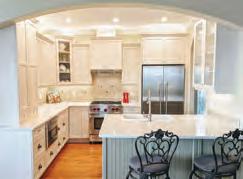








I LOVE ME
Lean into self-love with makeup and jewellery that give you joy
Meal-plan and meal-prep recipes for a happier, healthier you
What’s on trend for 2024?























46
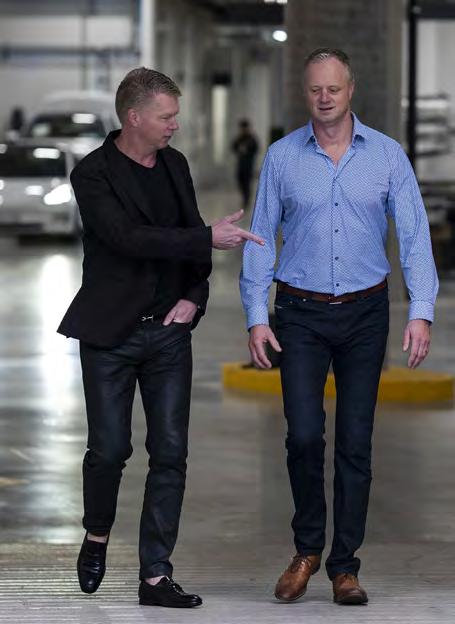
FEATURES
24 V INEYARD DREAMS UNCORKED
T he stunning, visionary home at Sage Hills Winery
B y Natalie Bruckner
30 I LOVE ME
Lean into self-love with makeup and jewellery that give you joy
B y Lia Crowe + Jen Evans
39 THE WORLD OF WELLNESS
What’s on trend for 2024?
B y Laura Goldstein
44 OASIS IN THE CITY
Vancouver’s new Nordic spa experience
B y Laura Goldstein
46 THE DISCIPLINE OF SELF-CARE
Meal-plan recipes for a happier, healthier you
B y Heidi Fink
52 TRIP OF A L IFETIME, TAKE TWO!
T he Galápagos Islands
B y Suzanne Morphet



DEPARTMENTS
6 CONTRIBUTORS
8 EDITOR’S LETTER
T he good coffee
B y Susan Lundy
10 LIFE. STYLE. ETC.
Amrita Guram
B y Izabel Kazenbroot-Guppy
12 I N STUDIO
Japandi style
B y Laura Goldstein
16 WEEKENDER
Culture, cuisine and a dash of football: Seattle
B y Toby Tannas
20 SPOTLIGHT
T he road to Ageless Living: Michael Forbes
B y Don Descoteau
36 BUSINESS CLASS
Auto experience elevated: No.1 Collision
B y Lauren Kramer
56 NARRATIVE Soaring
B y Susan Lundy
58 BEHIND THE STORY
B y Susan Lundy

NATALIE BRUCKNER
WRITER
VINEYARD DREAMS
UNCORKED
PAGE 24
“Sometimes you come across a property that has so much heart and soul, you can’t help but fall in love. That was the case with Sage Hills Winery. It was as if the story was always there just waiting to be written.” Originally from the UK’s south, Natalie eventually settled in Canada almost two decades ago. Today, she lives in her mountain cabin with her partner, Laurence, and their rescue dog, and shares their land with about 100 wild horses. With more than 25 years as a writer and published author, Natalie’s dedication to capturing the diverse spectrum of human experience is unwavering.
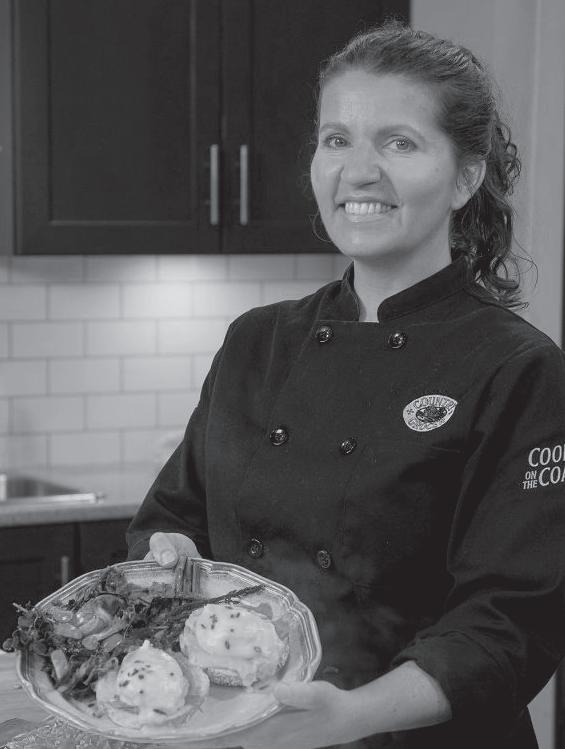
HEIDI FINK
WRITER
THE DISCIPLINE OF SELF-CARE
PAGE 46
“This month’s food subject the discipline of self-care—is so close to my heart that my biggest challenge was keeping it short and to the point! I could have written 10 times the amount to cover all my strategies around eating well in a busy life.” Chef Heidi is a culinary instructor, recipe developer, TV show host, food writer and busy mother of two, living on southern Vancouver Island.
2024 ISSUE 1
BOULEVARD GROUP PUBLISHER
Mario Gedicke
mario.gedicke@blackpress.ca 250-891-5627
MANAGING EDITOR
Susan Lundy
ASSOCIATE EDITOR
Lia Crowe
CONTRIBUTING WRITERS
Natalie Bruckner, Angela Cowan, Don Descoteau, Jen Evans, Heidi Fink, Laura Goldstein, Izabel Kazenbroot-Guppy, Lauren Kramer, Suzanne Morphet, Kaisha Scofield, Toby Tannas
DESIGNERS
Lily Chan, Nel Pallay, Maria Lobanova, Tammy Robinson, Crea Zhang
ADVERTISING SALES
Vicki Clark, Carien Wessels
PHOTOGRAPHERS
Lia Crowe, Peter Wingfield
ILLUSTRATION
Sierra Lundy
DISTRIBUTION
Marilou Pasion Marilou@blackpress.ca 604-542-7411
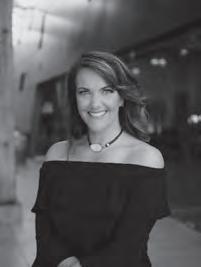
WRITER
CULTURE, CUISINE AND A DASH OF FOOTBALL
PAGE 16
“A sporting event is the perfect excuse
for a Seattle escape. The city comes alive when the Seahawks are at home. It’s a fun place to be even when you’re cheering for the visiting squad!” Toby is a regular contributor to Boulevard magazine. You can catch her weekday mornings on Kelowna’s 103.1 Beach Radio.
TOBY TANNAS
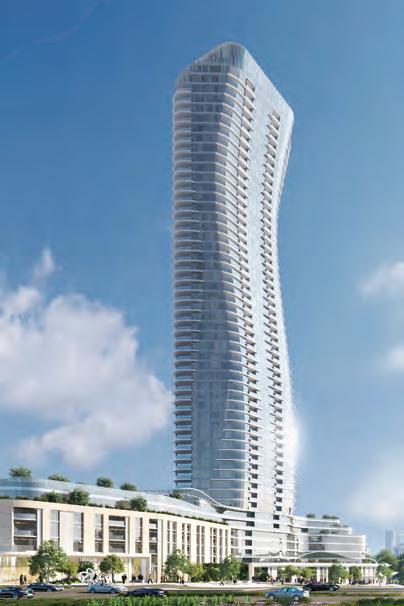

“Nice bakery and super nice guy,” Bruce mumbled as he leaned into the car, handing me two cups of coffee. “Not sure he knew what he was doing, though.”
I grabbed the cups. Ah, my morning java. Possibly the most important moment of my day.
“I asked for oat milk in yours and he said, ‘sure,’ and disappeared with it. But it doesn’t look like it came back with oat milk in it.”
I took a sip and sighed. “Ugh. No oat milk and not great tasting coffee.”
We were in a small Colorado town called Durango, heading to Santa Fe as part of a November across-the-USA road trip. This was my second attempt at coffee that morning: while l was out walking our dog in the frosty morning air, Bruce had found me a coffee from the hotel lobby. But it was lukewarm and undrinkable.
I sipped the bakery coffee again. It had an odd flavour. Familiar. But I couldn’t quite place it. Then… “Wait a minute! Ew! This is tea!”
You might “suckthings up” on the road. But never with tea instead of coffee. On this trip, I had mostly missed that moment of morning perfection: a steaming hot cup of dark roast with a dollop of barista-style oat milk. The elixir that fires up my day. These mornings I’d been sipping disappointment. Tepid, watery and with nothing close to a delicious non-dairy whitener. Most hotels seemed to favour Coffee Mate whitener, and it came in either a sad pile of powder or a gooey liquid. Usually flavoured and sweetened. Not my “cup of tea (coffee).”
PHOTO BY LIA CROWE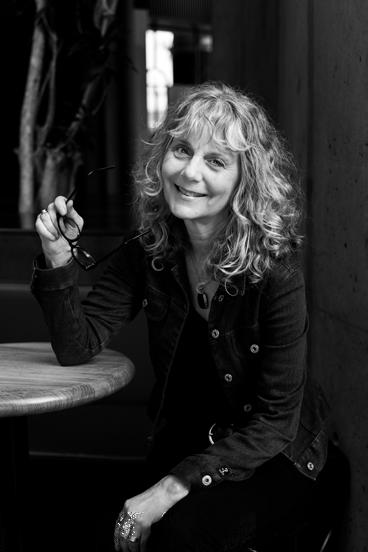
For this issue of Boulevard—with its self-care/wellness theme—a discussion around morning java seems fitting because self-care for me is ensuring access to coffee. The first thing I seek out in a hotel room is the coffee supply. At home, if there is any threat of a power outage, I grind enough coffee for the next morning and beyond. What could be worse than 6 am start, no power and no ground coffee beans? Water can be boiled on the wood stove or barbecue. But grinding the beans? I recall that my friend Shari, who is equally coffee-addicted, once used a sock and hammer to desperately grind her coffee beans during a power outage.
So, as we left Durango with our sad cups of tea, I eyed the unfolding landscape with a sluggish brain and attempted to find the right words for conversation. But they weren’t there. My mind was a muddled mess, and I felt a headache coming on.
Finally, we landed in the outskirts of the next town, Pagosa Springs, and headed for the first coffee shop that showed up on my maps app. But it was permanently closed. Never mind, there was another cafe nearby. But—there was no takeout coffee here. My heart broke a little bit at that stop.
But in the end, it was all for the best. The coffee that we found at a little riverside café in Pagosa Springs turned out to be the best cuppa of the road trip. And I inhaled it. I finished my first cup before Bruce had taken his third sip. I grabbed a second cup, and we enjoyed a leisurely walk along the river, where hot springs dotted little rocky outcroppings on the shoreline, and steam rose upwards, encasing me in a cocoon of steamy air and coffee bliss.
When we got back on the road, I could suddenly find my words again! Good words. Strong words. Complicated words. All pulled from my happily buzzing brain. Self-care complete!
In this edition of Boulevard, you will find wellness trends, self-care meal ideas and nods to good health. In the narrative section, I have written about selfcare amid grief. I hope you enjoy this edition. Try delving into it with a good cup of java.
Susan Lundy Managing EditorSusan Lundy is a former journalist who now works as an editor, author and freelance writer. Her latest book, Home on the Strange, was published in 2021 via Heritage House Publishing.

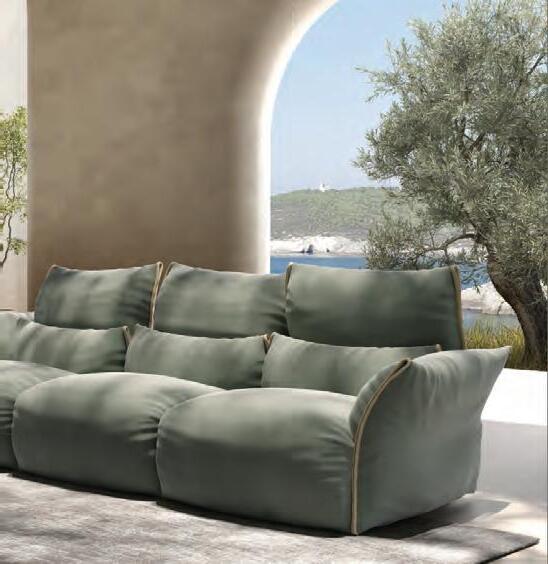



"In the transitional seasons of winter and spring, the design harmonizes with nature. I've always enjoyed the feeling of being close to nature, prioritizing natural light in the design. The aim is to seamlessly connect indoor and outdoor spaces for a cohesive experience. I recommend using materials in their natural state, featuring raw textures and warm earthy tones, combined thoughtfully with vibrant plants to welcome the spring of 2024."
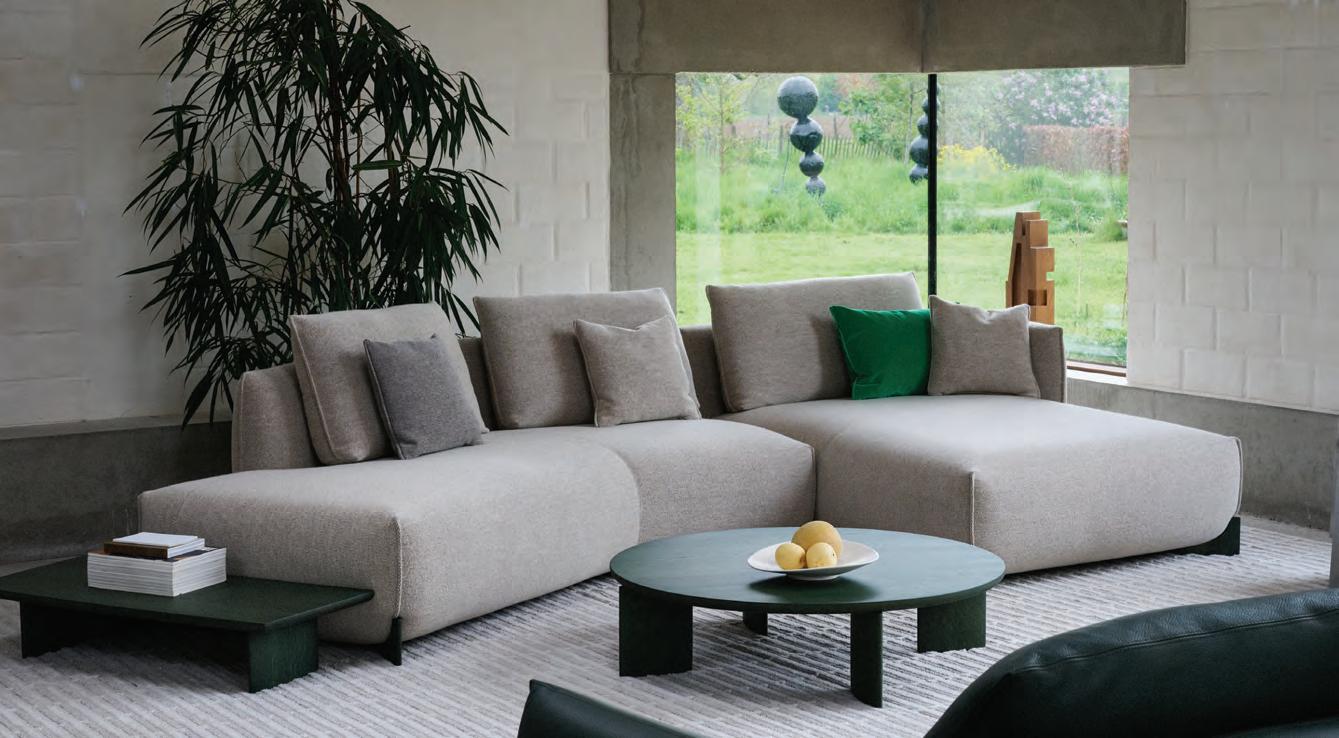

1275
1348-C


WHERE WERE YOU BORN AND WHERE DID YOU GROW UP?
I was born in Vancouver and I grew up in Burnaby.
WHAT HAS BEEN YOUR CAREER PATH?
I was a nurse at the BC Cancer Agency for most of my 20s and then transitioned into real estate in 2016. I started out in residential luxury leasing and sales, and then I made my way into commercial sales/leasing and land development. It’s amazing how many skills from my nursing background translate into dealing with all different types of clients.
WHAT IS THE ONE ASPECT OF YOUR WORK THAT REALLY GETS YOU FIRED UP?
Coming up with a win-win scenario between two parties.
WHAT ARE YOU PASSIONATE ABOUT OUTSIDE OF WORK?
I am passionate about maintaining a healthy balanced lifestyle, and I’ve recently started fundraising/ volunteering with the SPCA.
WHAT’S THE BEST LIFE LESSON YOU’VE LEARNED IN THE LAST FIVE YEARS?
It’s not always about what you’re saying, it’s about how you say it. Being tactful with delivery and mindful that your audience is everything.
WHAT INNATE QUALITY OR DAILY PRACTICE HAS LED TO YOUR SUCCESS?
My daily mantra is “get sh*t done.” Resisting the urge to procrastinate is huge.
WHAT IS GOOD STYLE TO YOU?
Having high-quality staple pieces that can easily be mixed and matched.
HOW WOULD YOU DESCRIBE YOUR PERSONAL STYLE?
At work: Sleek and polished. At home: Athletic, comfortable and cosy.
Style icon: Victoria Beckham.

Favourite fashion designer or brand: I’m into Helmut Lang at the moment.
Favourite musician: The Weeknd, J Balvin and Bad Bunny.
Film or TV show that inspires your style or that you just love the style of: Olivia Pope (Kerry Washington).
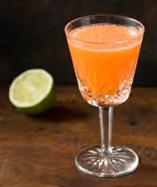

Favourite cocktail or wine: A “Naked and Famous” cocktail. Music on current rotation: Playlist on rotation is “Chill House” on Apple Music.
Favourite flower: Peony.
Favourite city to visit: Lima, Peru. Favourite app: Instagram.
Favourite place in the whole world: The Amalfi Coast. One thing that consistently lifts your spirits during hard times: I love the feeling after getting a good sweaty workout in.
Uniform: My work uniform is normally a dress, heels/boots and a blazer, plus a select few accessories. All-time favourite piece: A Mackage jacket I bought back in 2007. It’s timeless and has been in rotation every few years! Currently coveting: A new everyday handbag (of course).
Favourite day-bag: I’m guilty of overusing and putting snacks in my small Givenchy Antigona bag.
Favourite work tool: My iPhone and laptop! Favourite jewellery piece or designer: I was just gifted a gold Cartier Juste Un Clou bracelet.
Fashion obsession: Outerwear! I cannot have enough jackets, coats or blazers.
Accessory you spend the most money on: Handbags. Necessary indulgence for either fashion or beauty: Dyson hair tools. Dyson hair dryer and the Dyson Airwrap.
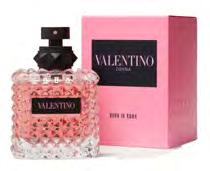
Moisturizer: Aveeno.

Scent: Valentino Donna Born In Roma
Eau de Parfum.
Must have hair product: Olaplex Oil.
Beauty secret: Stay hydrated and well rested.
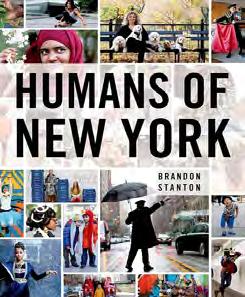

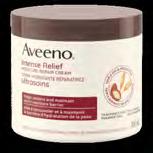
What you read online for style: Vogue.com.
Fave print magazine: Architectural Digest
Fave style account to follow: Instagram:@micahgianneli. Coffee table book/photography book: Humans of New York, by Brandon Stanton.
Last great read: Greenlights, by Matthew McConaughey. Book currently reading: Friends, Lovers, and the Big Terrible Thing, by Matthew Perry.
Favourite book of all time: A Fine Balance, by Rohinton Mistry.

“Japandi (a fusion of Japanese and Scandinavian minimalist design) has been resonating with me for a long time. Minimalism, which is very much my aesthetic, also originates from Japan. It’s all about using raw materials: clean, large-scale slabs, metals and wood.”
The floating world. Living in the moment. Savouring the moon, the snow, the cherry blossoms and the maple leaves. Detaching from life’s everyday problems. That is the meaning of the Japanese word ukiyo, the name given to the newest Japandi-inspired Dekton Collection, designed by Claudia Afshar in collaboration with Cosentino, a family-owned sustainable surfaces company.
We are sitting in Cosentino’s vast 4,293-square-foot showroom in Vancouver’s Armoury District (a smaller showroom is located in Burnaby), and the area is festooned with a stunning array of towering pink silk cherry trees in full bloom. It’s an amazing tribute to Claudia Afshar’s sophisticated new UKIYO Collection of textured interior and exterior natural cladding. It’s also a serendipitous collaboration, because as Claudia was surprised and delighted to learn, Vancouver is a twin city with Yokohama, Japan, and the country has gifted hundreds of cherry trees to the city, beginning in the 1930s. And just across the water, Victoria is a “sister” city to Morioka, Japan.
“As a kid I was always rearranging the furniture in my bedroom and driving my mom crazy,” laughs Claudia, the London-born, Los Angeles-based founder and principal of Claudia Afshar Design. Although professionally trained in ballet and contemporary dance, Claudia seemed destined to continue the family business.
“My mom, who was an interior designer, had a wonderful showroom in Belsize Park in London. It consisted of architects, a building team and one of the largest fabric houses. So, I remember as a kid getting lost in all the fabulous fabric samples. Later, when I wasn’t dancing, I’d intern there. And without
really thinking about it, interior design just became embedded in me,” she says.
“Japandi [a fusion of Japanese and Scandinavian minimalist design] has been resonating with me for a long time,” confesses Claudia, whose attention to detail has garnered client accolades from around the world. “Minimalism, which is very much my aesthetic, also originates from Japan. It’s all about using raw materials: clean, large-scale slabs, metals and wood.”
She adds: “And we share many of those same elements here in the Pacific Northwest that have had a profound influence on interior design, furniture and architecture. Our profusion of beautiful natural woods like Douglas fir, oak, red cedar, maple and alder, are often juxtaposed and accessorized with brass, bronze, copper and gold decor.”
Dekton by Cosentino is a carbon-neutral ultracompact porcelain surface, created by combining over 20 minerals compressed under high pressure, making it extremely durable and stain and scratch resistant. It’s so strong, it can easily be adapted to curved edges without worry of breakage. Used in multiple iterations, the new UKIYO Collection has vast applications besides wall facades.
“There’s a tremendous diversity for this product,” says Claudia. “It can be used around kitchen islands, stairs, bath and spa cabinetry and fireplace surrounds, as anti-slip flooring and even for poolside exteriors that extend the fluidity from indoor to outdoor spaces. And there are so many ways that UKIYO Dekton can be incorporated into furniture. We’ve already created a chaise lounge and a trolley bar on wheels using the collection and we’re really excited about them.”
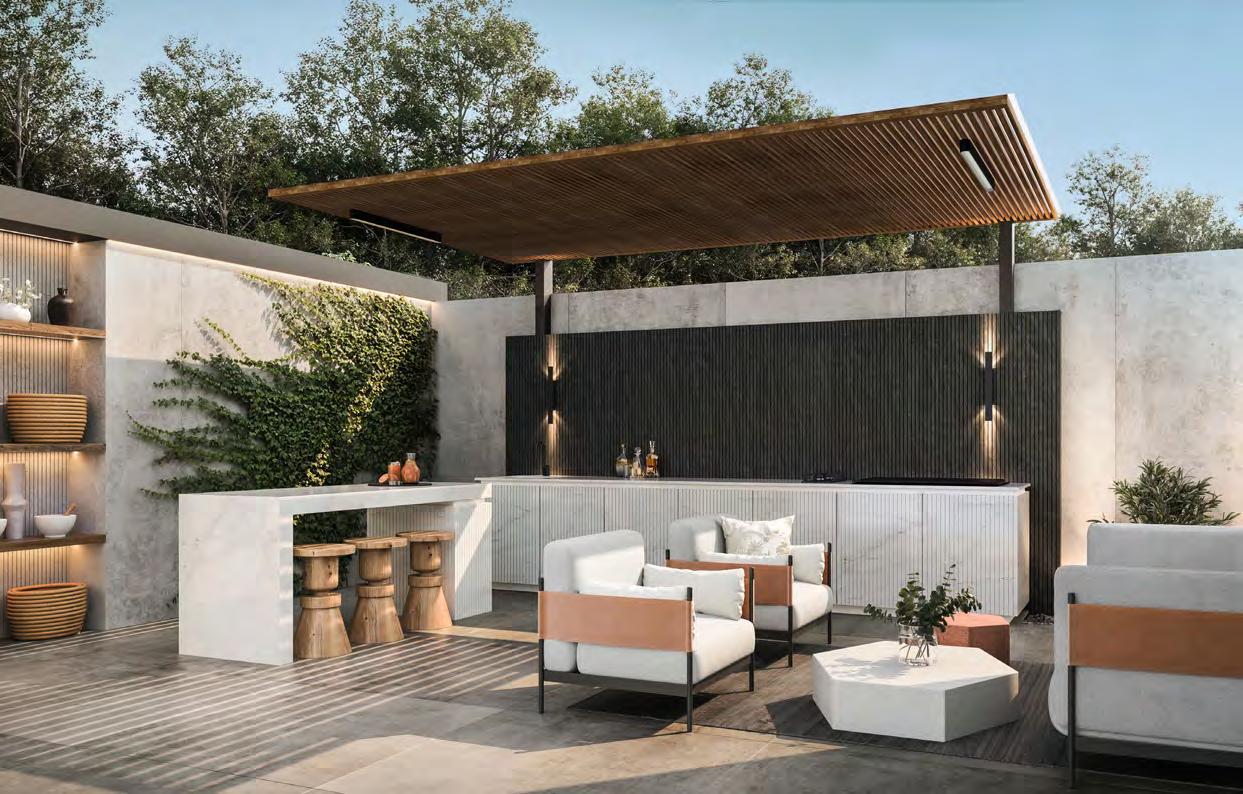
Inspired by nature and the organic world, Claudia says she “takes the littlest snippets of the tiniest discoveries from my travels, like the cobbled streets in Europe or the way the water ripples when a rock hits it,” and expands on those images when designing.
“My 10-year-old daughter, Paisley, and I were in Malibu and she was running along the beach and said ‘Mummy, look at this stone.’ And I thought, this is an amazing stone, very weathered and decayed, I have to use it in one of the designs for this project—so I did!” Claudia laughs.
Like an enveloping cocoon that brings warmth to any room, UKIYO is available in two structured, fluted-pattern widths that reflect a subtle geometric texture, and five matte colours that cast a sensual calm and feeling of wellness over any environment. Dekton Bromo is a dark slate grey shade that evokes a moody atmosphere; Dekton Umber recalls the warm natural pigments of earthy terracotta, like the roof tiles found in the south of France, Spain, Mexico and Morocco. The neutral Dekton Nacre is an organic cream shade that evokes the colour of mother-of-pearl inside a mollusk shell. Inspired by cement, Dekton Kreta can create lighter or darker dimensions,
depending upon the density of the fluting. Dekton Rem captures the subtle elegance of brown and grey veining with hints of gold.
Claudia notes that Pantone’s Peach Fuzz, the 2024 Colour of the Year, is a great coordinating hue.
“People have asked me ‘why such neutral colours?’ This was intentional because they are staples that can be mixed and matched to other Dekton products with more vein or vibrant colours, as well as wood or natural stone. Having said that, we’re in discussions to introduce more colours and textures in the future,” says Claudia.
Her passion for design and the UKIYO Collection is palpable but that doesn’t mean it’s time to rest.
Claudia is already working on high-end lighting, furniture and a nature-inspired rug collection to launch in 2025.
“You know, working with Cosentino was a dream— we understood each other creatively and we are so mindful of not designing anything that I wouldn’t love to have in my own home.”
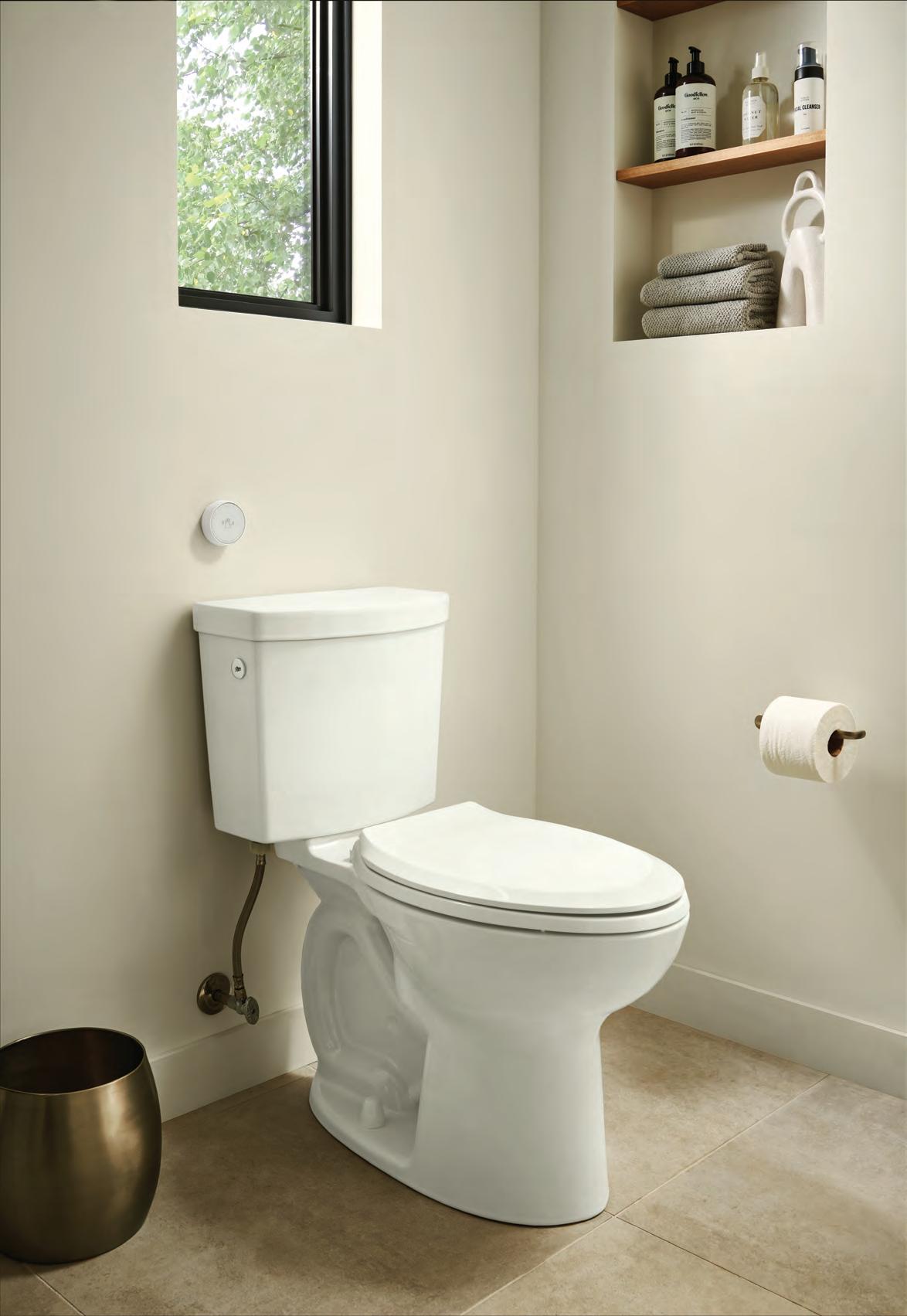

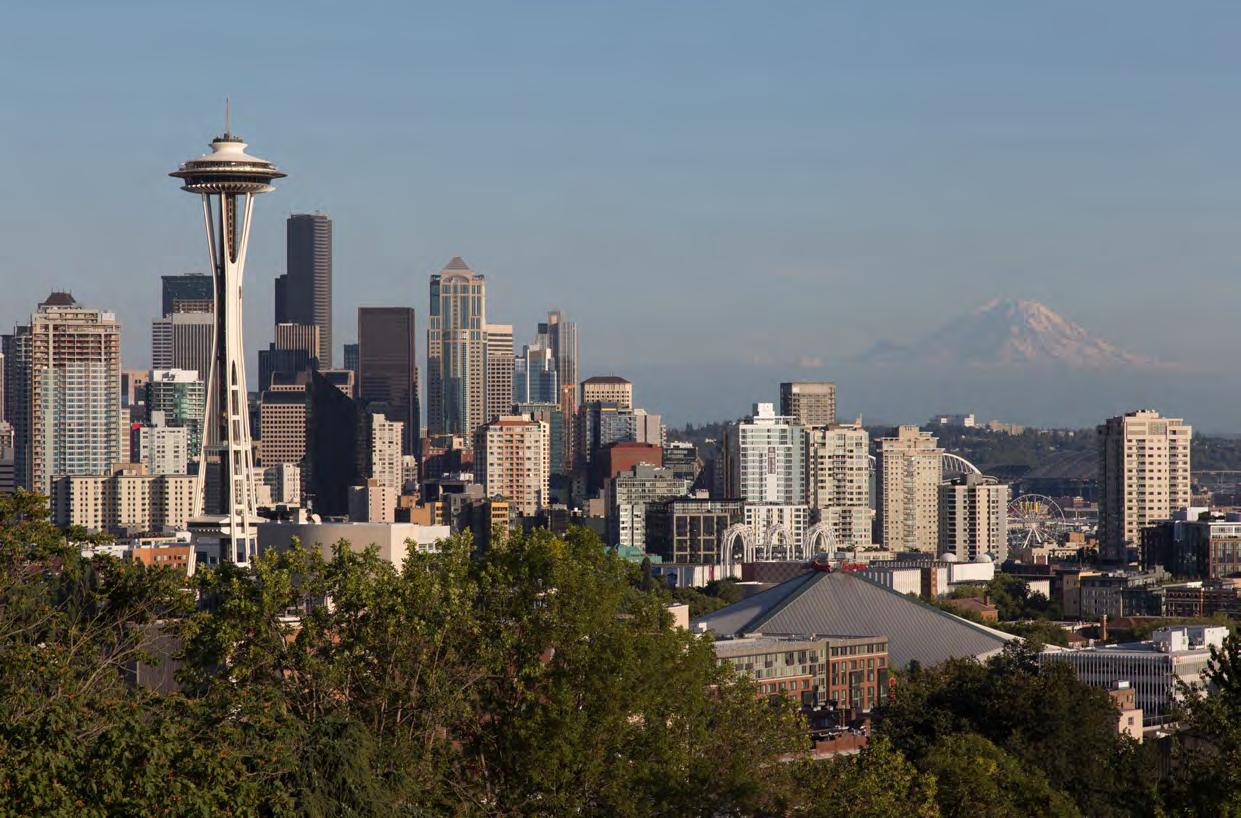
Seattle has all the ingredients for a fun-filled weekend getaway
WORDS TOBY TANNAS PHOTOGRAPHY COURTESY VISIT SEATTLE AND THE ARCTIC CLUB
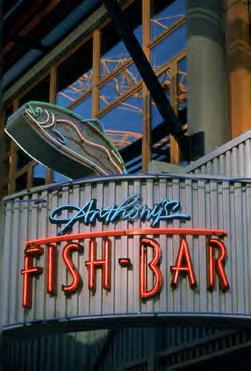

What do football and seafood chowder have in common? Both are very good reasons for an early winter trip south of the border. Since my favourite NFL team was slated to play the Seahawks in Seattle, it was the perfect excuse for a weekend getaway to the Emerald City.
With my husband in the driver’s seat, we set out on the easy drive from Vancouver. In under three hours, we rolled into Seattle’s downtown core and our hotel destination, The Arctic Club. Situated in the heart of downtown Seattle at the corner of 3rd Avenue and Cherry Street, this historic hotel is an easy walk to Lumen Field, the famous Pike Place Market and Pioneer Square.
The best part about staying in downtown Seattle is you can park your vehicle and forget about it. Most of what you come to see is within walking distance—but be warned, there are some serious inclines. (More about that later!)
We were excited to explore the city but the moment we climbed the marble steps of The Arctic Club we were entranced. The history is palpable the moment you step through the doors.
Before it was a hotel, The Arctic Club was a social club. It was established in 1907 for successful veterans of the gold rush to gather and share tales of “striking it rich!” At the time, Seattle billed itself as the Gateway to Alaska (despite Canada being situated between the city and America’s northernmost state). Many a business was set up to “mine the miners,” as they say. The Arctic Club was the most successful of this lot and for those with a thirst for adventure.
The walls of the grand lobby are adorned with portraits of
each founding member. The photos were taken by renowned photographer of the time Edward Curtis. He is said to have rung up quite the bar tab at the club and used his camera skills to pay it back. Curtis was best known for his striking photographs of Native Americans, of which there are many throughout the hotel.
Beyond the welcome desk, we were drawn to the oversized fireplace flanked by two large sofas. The wood-panelled room is warm and inviting, dotted by tables for gathering and situated adjacent to the stunning Polar Bar. Keep an eye out for the glowing polar bear statue, just one animal theme in the hotel. The walrus is also a mascot, appearing in The Arctic Club logo as well as in the plaster on the A. Warren Goulddesigned facade and in plush versions at the gift shop.
Our room is on the 10th floor, top of the heap with some incredible views of Seattle. We are delighted to see Lumen Field lit up from our private balcony.
The guest rooms, once offices of the club’s founding members, have been renovated with history in mind, including classic wallpapers, charming tile, dark wood and fun details like double doors with mottled glass leading to the bathroom. All the modern amenities are at your fingertips.
Like The Arctic Club, Seattle is a city rich in history, much of which lies underground. With our walking shoes on we take a short (downhill) walk on Cherry Street to Beneath the Streets, a guided walking tour of Seattle’s sub-city. This is an amazing opportunity to learn about life here before the Great Seattle Fire of 1889. Fire destroyed the entire central business district but ultimately the rebuilding provided the city an op-
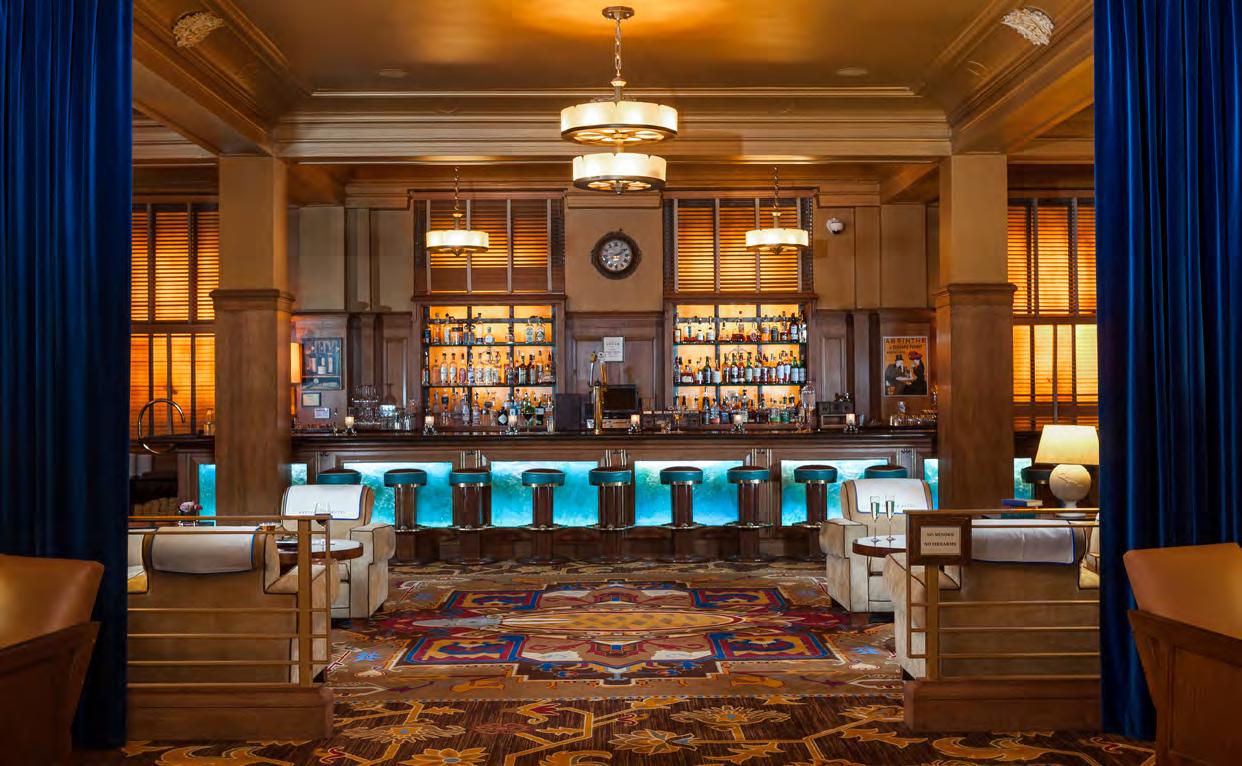
portunity to correct some major engineering and building flaws. Seattle was essentially “lifted” to protect it from high water (hence the urban hills). Much of the lower city remains under the sidewalks. Our tour guide was engaging, offering many tidbits about early life in Seattle.
With a road trip and subterranean tour under our belts it was time for lunch. Many friends recommended The Crab Pot in Miners Landing Pier 57. We took the waterfront route and about 15 minutes later we were seated in this fun, high-energy eatery, and tempted by the Seafeast, where diners put on a bib and get their hands dirty with an incredible-looking seafood feast dumped right on the table. There’s a bucket on the floor for shells and a roll of paper towel at your disposal.
We opted for the hearty clam chowder in a bread bowl—I’d been dreaming about it since we left BC! The Crab Pot did not disappoint and chased away the chill of the drizzly day.
With full bellies, we walked a bit further down Alaskan Way and up to 1st Avenue and the iconic Pike Place Market. You must linger a moment to catch the singing fishmongers, then line up (yes, there is always a line) at the very first Starbucks in the world. This is an Instagram moment, so don’t be surprised if you’re asked to snap a photo or two for excited tourists.
If you have an eye for architecture, you will appreciate the Romanesque Revival buildings in Seattle, many of which are found in Pioneer Square. This oasis within the city is filled with galleries, coffee shops and bars.
There are also food trucks, bocce courts, ping-pong tables and the Waterfall Garden Park. It’s an escape from the concrete jungle and I imagine many office workers would choose to lunch or unwind here when they need a break.
The history is palpable the moment you step through the doors. Before it was a hotel, The Arctic Club was a social club. It was established in 1907 for successful veterans of the gold rush to gather and share tales of “striking it rich!”
We begin the walk back to The Arctic Club (uphill this time) and arrive just in time for happy hour at the Polar Bar. It also offers a delicious dinner menu that’s served until late. We decide to turn in early with more exploring and football on tap for tomorrow.
Game day starts with a complimentary hot breakfast in the hotel’s Juno Cafe and then we head back out into the city to partake in fun and fandom.
Seattle is a football-loving city and fans from both the home and visiting team are everywhere. Pioneer Square bars and pubs are packed, and it’s a festival atmosphere around Lumen Field in the hours leading up to game time.
The game itself does not disappoint (even though my team did not win) and the walk back from the stadium is filled with hoots and hollers from excited Seahawks fans. We take some ribbing in our team colours but it’s all in good fun—Seahawks fans are friendly!
After another solid night’s sleep in our quiet and comfortable room, we hit the I-5 for our return trip north. Of course, we make a stop at the Seattle Premium Outlets in Tulalip and grab a few essentials from Trader Joe’s. A short wait at the Peace Arch border crossing and we are back in Canada.
A west coast seaport like Vancouver, Seattle manages to offer up something both familiar and decidedly different. Whether you come by car or airplane, Seattle is the perfect weekend escape when you don’t want to venture too far from home.
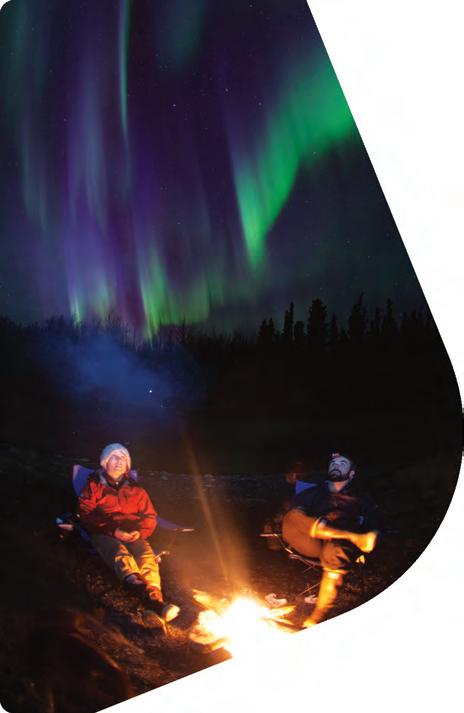
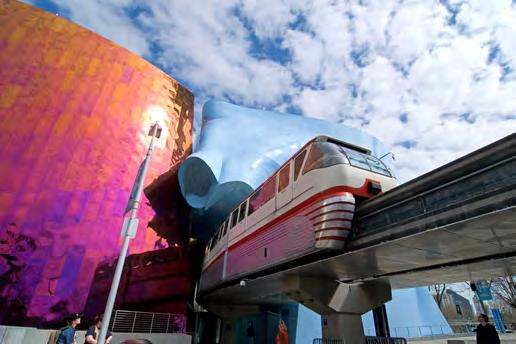

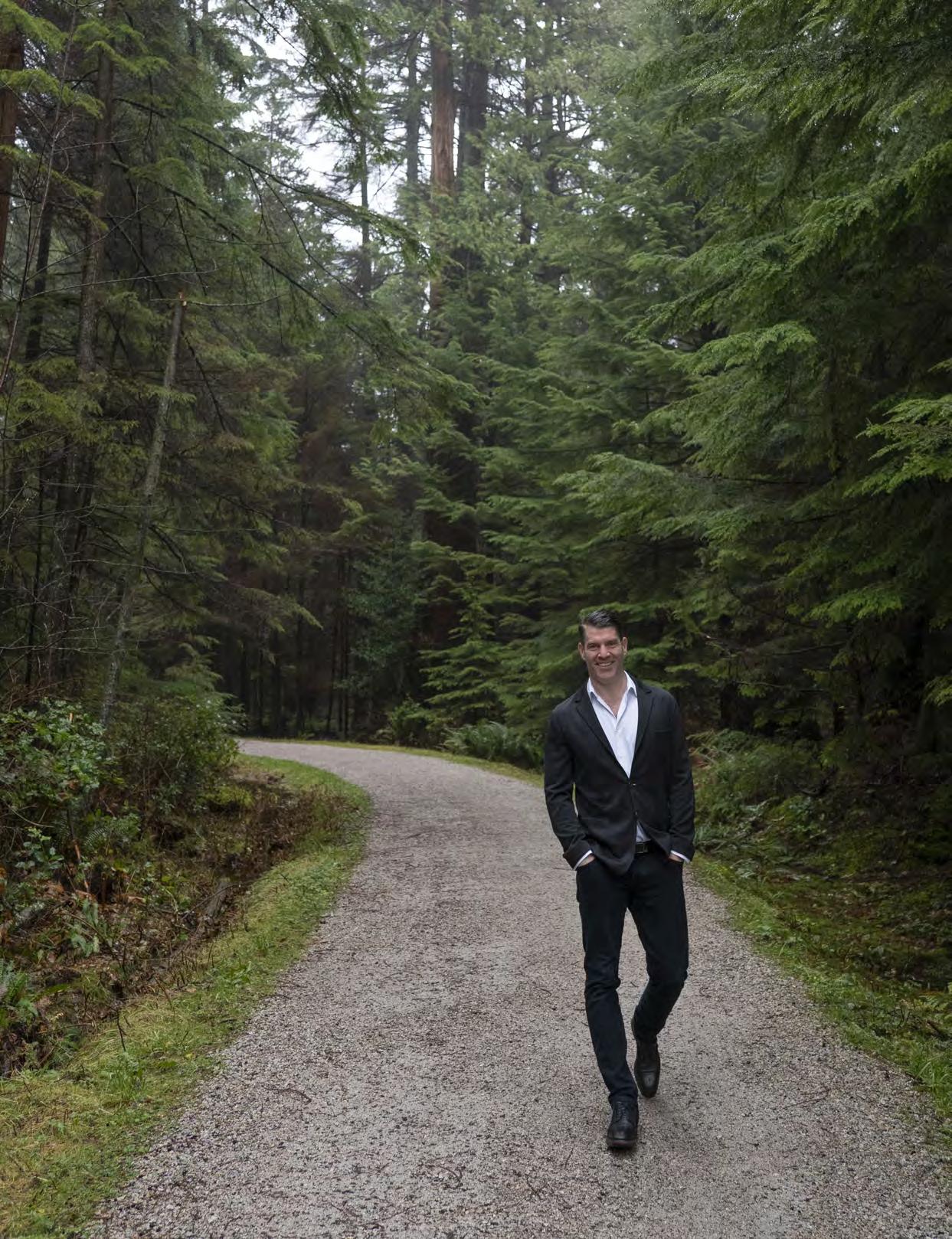
s a practising pharmacist in BC, Michael Forbes worked with clients across the age and general wellness spectrum. For the most part, his early work was conducted within the confines of the traditional health care system, aimed more commonly at treating symptoms rather than providing preventative health solutions.
Always curious about science and innovation, he quickly realized there were more effective and personalized ways of helping people, even as their bodies were aging or, in some cases, being attacked by disease.
“I try to find enhanced ways to help more patients feel better—that’s where my curiosity has led me,” he says during one of his “rejuvenating” walks through Stanley Park in Vancouver, near where he spends much of his time these days.
As a young pharmacist in the mid-2000s he began compounding medications—combining multiple drugs—as a way to provide a more tailored treatment for his clients. In the years since, his research into the field of longevity medicine and the use of plant-based medicines has fuelled his company’s health services expansion into the Lower Mainland, the Okanagan and Alberta.
No longer working daily in the pharmacy, Michael has gradually shifted his focus to overseeing his wide range of business enterprises. His passion for helping people feel better longer and get more out of life, however, continues to be a primary driver in his entrepreneurial pursuits.
Michael’s investigations over the years have included conversations with leading specialists in internal medicine, complex care, aesthetics and other areas, and ultimately led him to develop his own concept of being one’s best at any age. The idea was to create an integrated medical practice that focuses on age management, using cutting-edge, evidencebased medicine and technology. The philosophy is central to the Ageless Living wellness centres he’s opened in Victoria, Langley and Kelowna.
The emerging science of longevity medicine, a practice being increasingly embraced by general practitioners and specialists—and invested in heavily by some of the world’s best-known tech billionaires—developed out of a realization that aging is the greatest risk factor for most acute and chronic diseases. It looks for ways to interrupt that typical pattern.
The people who come to his Ageless Living clinics aren’t necessarily looking to slow the aging process, Michael says, but are motivated to feel better or address some problem that is preventing them from living a healthy, enjoyable life.
“Usually, there’s something there, whether it’s lack of libido or hot flashes or insomnia or just feeling low energy. Say they had a genetic test done and they’re worried about their risk of cancer,” he says. “It’s more about not just slowing aging per se, but what’s in it for them to feel better and to reduce what’s important to them with their risk. It’s very personalized medicine; everybody is different.”
One example of the services the clinic offers, hormone testing aims to source out imbalances that can lead to everything
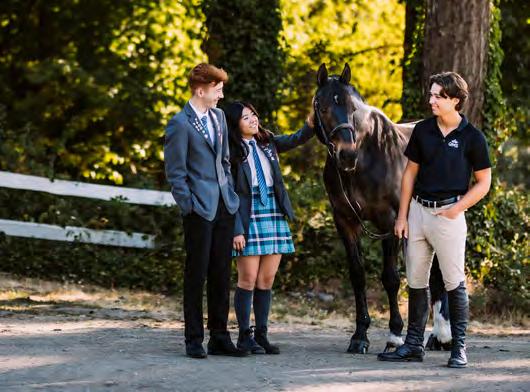



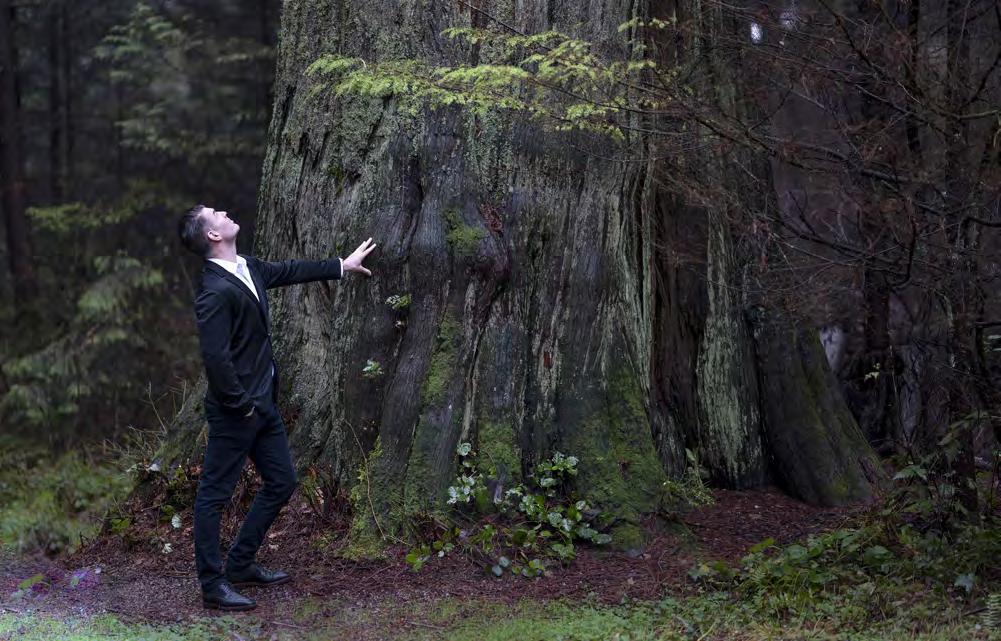
“It’s more about not just slowing aging per se, but what’s in it for them to feel better and to reduce what’s important to them with their risk.”
from wrinkles, weight gain or low libido to mood swings, stress and fatigue.
Women enduring menopause have tried hormone replacement therapy (HRT), but Michael says the increased risk of cancer found with that treatment led researchers to find better ways of correcting patients’ hormone imbalances. Today the testing provides a road map for the creation of bio-identical hormone restoration and optimization options.
As Michael learned more about the ways technology can enhance personal health care, he took a leap into services such as “biohacking.” All three Ageless Living clinics feature a hyperbaric oxygen chamber, infrared sauna and pulsed electromagnetic field therapy (PEMF), treatments that aim to optimize the body’s internal healing properties.
Michael admittedly doesn’t dip his toe in the water of new opportunities he finds exciting or innovative—he goes in deep. Such is the case with his involvement and investment in the cannabis industry, which ranges from producers to retailers. He was an early adopter even before the sale and use of cannabis became fully legal in Canada; for example, he studied how plant-based treatments could help people address everything from chronic pain to anxiety and insomnia.
“Cannabis was controversial at the time, but when you’re on the edge of new therapies, it can be scary for those who aren’t used to change,” he says, noting some people cautioned him against going all in.
Michael saw a major movement in the pharmaceutical industry toward manufacturing drugs that tried to mimic what nature was already providing. The way he sees it, the human brain and central nervous system have evolved to the point where plant-based treatments are the “perfect fit.”
“There’s a huge benefit, in some cases, for plant medicine over pharmaceuticals,” he says. “So, as a curious person, I really loved the science around that and that’s what got me intrigued by the potential of cannabis to help more people.”
When it comes to his investments in longevity medicine and cannabis, Michael considers himself a “curious and flexible explorer,” willing to take risks when the science backs it up.
“You’ve gotta be okay to wait and be patient. I always look at it like ‘How long can you stay in the swamp before rising out of it like a phoenix?’ You’ve got to get comfortable in the swamp, because it can be a long time.”
He’s excited about the intersection of technology and health care and sees the future use of AI as a way to further enhance personalized treatments.
“I can’t express enough how passionate I am about longevity medicine and the AI interface that I’m working on with Ageless Living and how many more lives that we can help,” he says.
“It’s a fascinating time we’re in.”
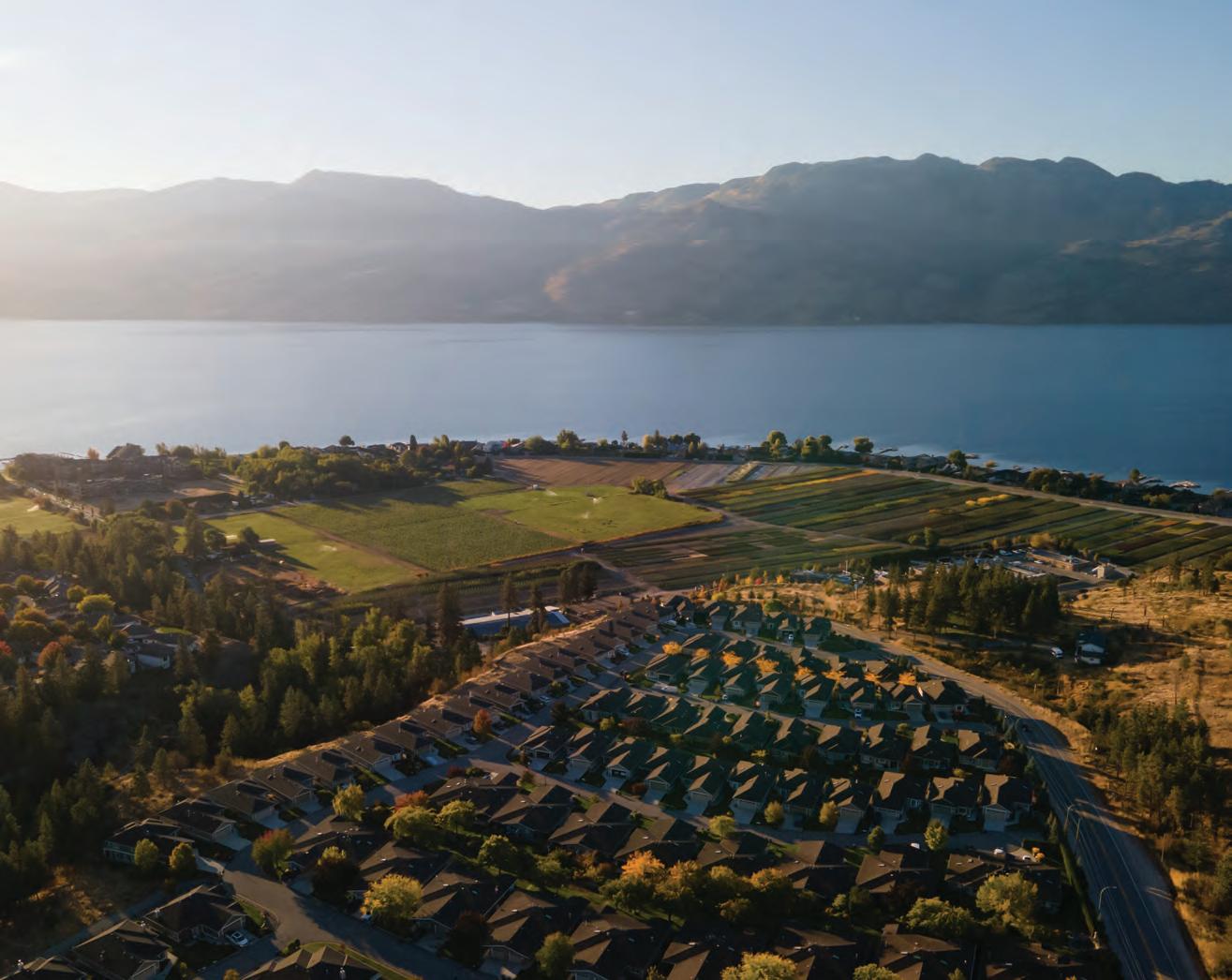
BRAND IDE N TITY GUIDELINE S
CUSTOM HOME LOTS & LUXURY VILLA HOMES
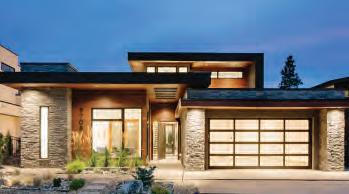
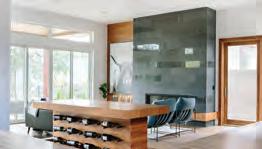


Set high above the horizon, Shorerise is an exclusive master-planned community that offers an elevated way of life. Inspired by the surrounding mountains, valley, Westside Wine Trail and Okanagan Lake below, this is a place where the architecture is distinctively Okanagan and the hillside trails offer a world of wonder outside your front door. Here, you’re only moments away from the beach, the lake, a round of golf, a hike or a glass of wine savoured with family and friends.

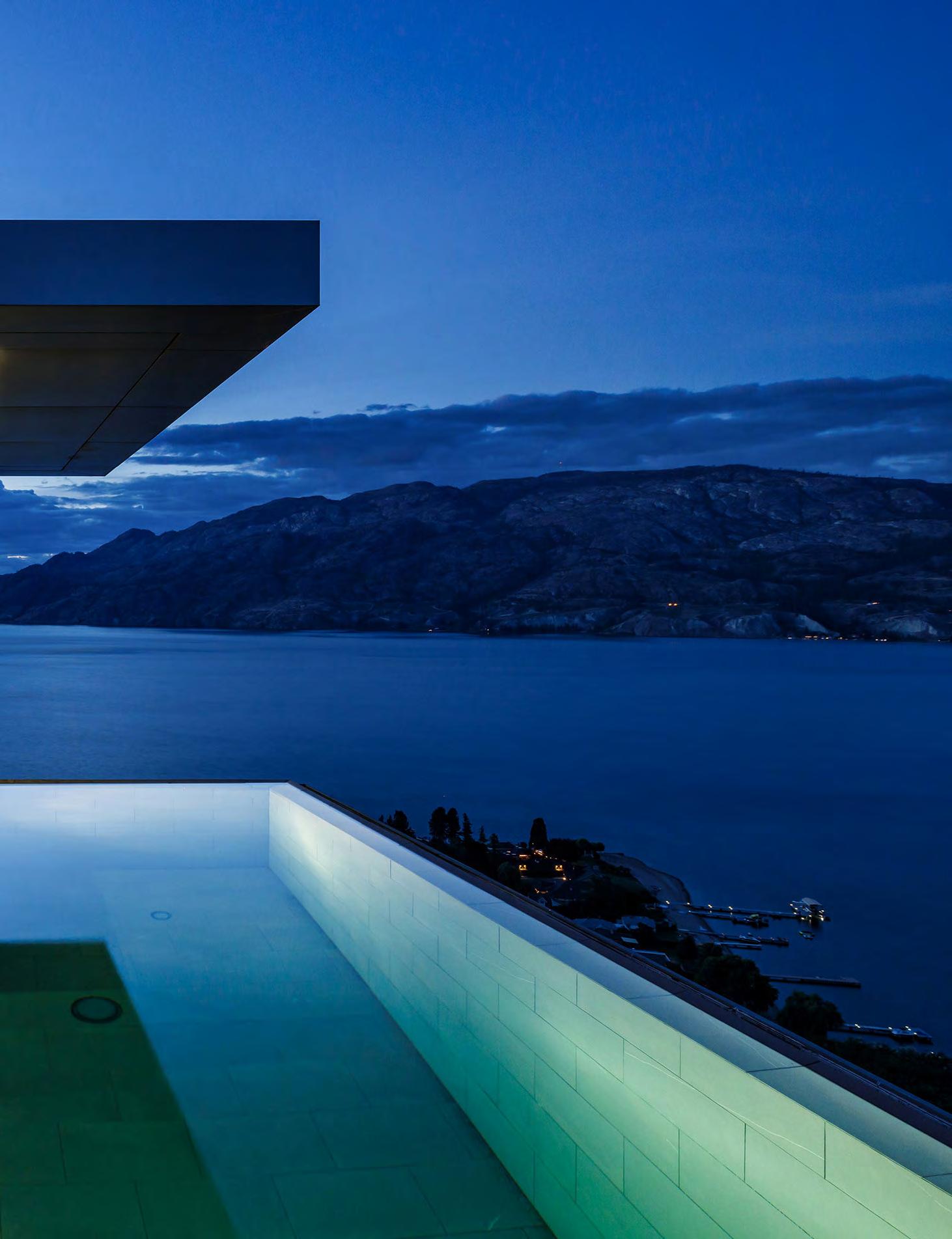
T“he good building is not one that hurts the landscape, but one which makes the landscape more beautiful than it was before the building was built.” Reflecting on these words by the great American architect Frank Lloyd Wright, it’s as if he was referring to this property in Summerland—the one I had the privilege of exploring on yet another blue-sky fall day here in the Okanagan.
Established in 2006, this property seems to share an ageless connection with the land, seamlessly integrating with its surroundings—an integral part of the natural poetry that has unfolded for centuries.
Nestled gracefully on the mountainside, a breathtaking panorama unfolds, revealing Okanagan Lake stretching majestically below. To the north, Peachland graces the horizon, while to the south, Penticton beckons with its rustic charm. Here, the melodies of the infinity pool harmonize with the sweet notes of birdsong, creating a serene escape from the hustle and bustle of life. This is Sage Hills Winery.
Established in 2006, this property seems to share an ageless connection with the land, seamlessly integrating with its surroundings—an integral part of the natural poetry that has unfolded for centuries.
It’s no surprise that the current owners, Rick Thrussell and his wife Toby, attribute the design of this architectural masterpiece to the influence of the aforementioned Frank Lloyd Wright.
“When we designed the home, I wanted everything to be very modest. Even the façade deliberately avoids the ostentatious. It’s a philosophy of ‘hide the elephant,’ avoiding grandiosity to embrace understatement, a subtlety that, to me, exudes even greater sophistication,” says Rick.
The couple’s journey since acquiring the 10.36-acre parcel
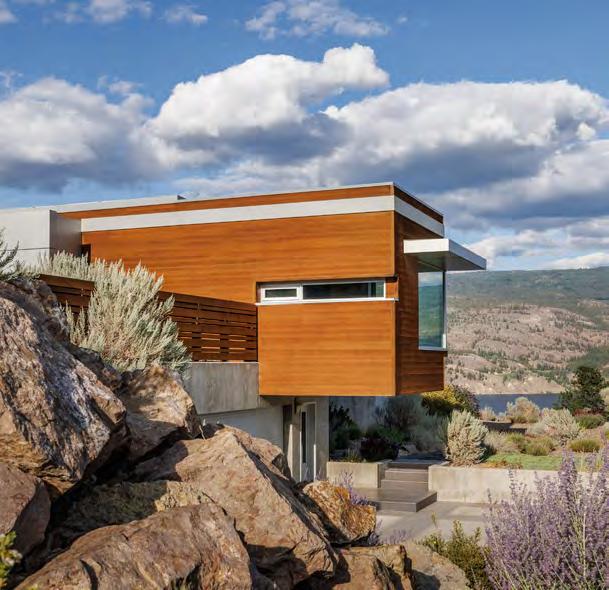
has been nothing short of extraordinary. Their vision extended to cultivating vineyards, creating a sustainable, certified-organic winery with state-of-the-art wine-making equipment, an inviting tasting room and, eventually, a spacious outdoor patio.
“Our goal was to nurture grapes perfectly suited to the unique character of our site,” Rick explains, encapsulating the essence of their daring venture.
Turning such a dream into reality required a profound vision and two years of construction. Even the house underwent numerous design iterations to ensure every aspect aligned seamlessly with the envisioned future.
“We crafted a 3D model, subjecting it to rotations to guarantee that its bedrock orientation allowed for optimal light penetration without succumbing to excess solar gain,” Rick shares.
In its essence, the home exudes timelessness, yet, as Rick points out, practicality takes precedence.
“I love Alucobond, for example, as it’s very low-maintenance—rain actually cleans it. And as for the driveway, I can clean the entire thing with nothing more than a leaf blower,” he adds with a hearty laugh.
Strolling along the driveway—its stamped concrete artfully mimics granite—and past the helicopter pad on the left toward the residence, an enchanting union of architectural brilliance and natural grace unfolds. The unassuming front door serves as a harbinger of the inviting warmth that characterizes the interior.
“Modern contemporary homes often risk feeling cold, so I sought to infuse warmth into every corner,” says Rick, sharing his design ethos.
Stepping inside, an instant feeling of “home” wraps around me. The acoustics, almost magically muted, weave a soothing ambience that harmonizes with the feng-shui-inspired lines of the space and the soft, muted colours. Despite its generous 4,576 square feet of interior living space, it feels remarkably cosy. Turning to the left I find a snug den—a tranquil sanctuary offering a peaceful retreat with a captivating view that unfolds over the expanse of the lake.
Emerging from the den, a grand kitchen stands before me. It’s a culinary haven with a sprawling preparation area that embodies the essence of clean lines and simple-yet-exquisite design. Every element is meticulously flush and understated, contributing to the creation of a space that exudes harmony. Overhead, flyovers in the ceilings elevate the aesthetic appeal and imbue the acoustics with a comforting warmth. I imagine, as the seasons shift, the floor-to-ceiling glass doors in the kitchen graciously yield to the allure of the pool area and deck.
To the left of the kitchen, steps lead to an elevated dining area adorned with floor-to-ceiling glass walls. Here, a double-
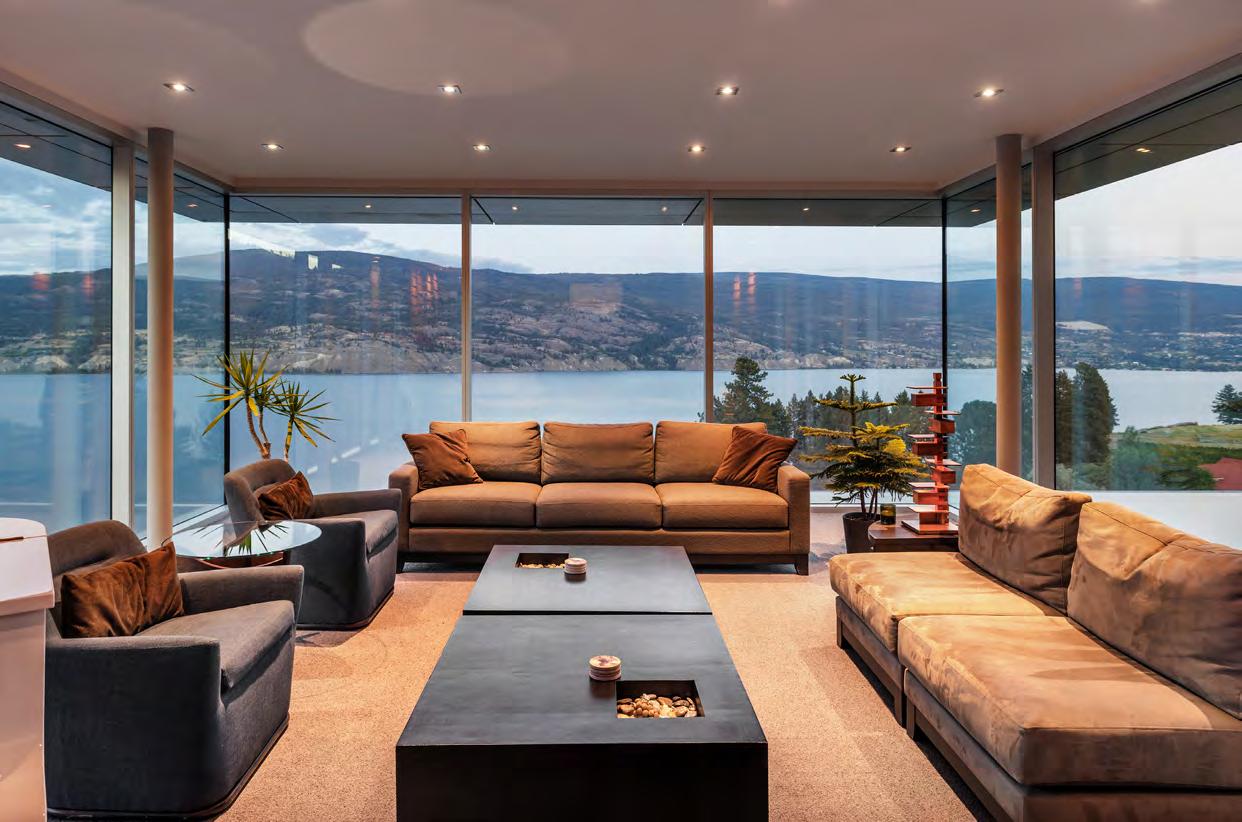
sided fireplace is enveloped in Banff rock from Mount Rundle. Beyond the dining area is the lounge, cantilevered daringly over the rock below, presenting a panoramic theatre of almost 230-degree lake views. I can envision this space not only as the perfect setting for capturing mesmerizing sunsets, but also as a stage for an auditory symphony, thanks to its flawless acoustics, enhanced by the presence of carpets featuring a luxurious combination of rubber underlay and organic wool.
Rick, sharing insights into the interior, remarks, “The wood, weathered by time, comes from old-growth comb-faced material—a remnant from previous projects. It infuses the space with warmth.”
His vision was clear—to craft an architectural masterpiece that transcends personal taste, where modesty becomes the linchpin of its allure.
Accessible from these spaces is the seamless connection to the pool deck—a retreat where an outdoor kitchen and an infinity pool elevate the sensory experience.
As Nate Cassie, partner at Hall Cassie Real Estate Group, aptly remarks, “It doesn’t get any better than that.” He makes a valid point.
Retracing my steps toward the front door, I veer left, discovering a discreet powder room and then the grandeur of the master suite. This private haven features a spacious walk-in closet and an exquisite bathroom with a rounded shower
room—a design gem visible from the exterior.
The stairs to the lower level boast floor-to-ceiling glass, offering 15-foot-high views of meticulously manicured gardens. Venturing further, the first nook reveals a practical mudroom and three-car garage. Beyond lies a cedar-scented wine room and then, the beating heart of the home, a mechanical area showcasing the geothermal system.
Across the hallway lies the home theatre room with an adjoining bar area nestled seamlessly into the rock. Three additional bedrooms, named The Vancouver Room, The Okanagan Room and The Arbutus Room, offer distinct yet spectacular views, with each adorned in muted hues reflecting their names. On this level, a shared bathroom and an en suite for The Arbutus Room provide a unique shower experience with views extending over the lake and vineyard below.
As expected of a home of this caliber, there is a state-ofthe-art Crestron smart home system, orchestrating everything from security to a curated musical ambience.
The house may stand as a centrepiece, yet Sage Hills offers much more—a captivating organic winery and accompanying structures. Upon entering Sage Hills Winery, I discover an elegant building housing wine operations and a chic tasting room, adorned with solar panels that make Sage Hills the district’s largest solar energy generator.
Outdoors, an inviting patio emerges, offering wine and
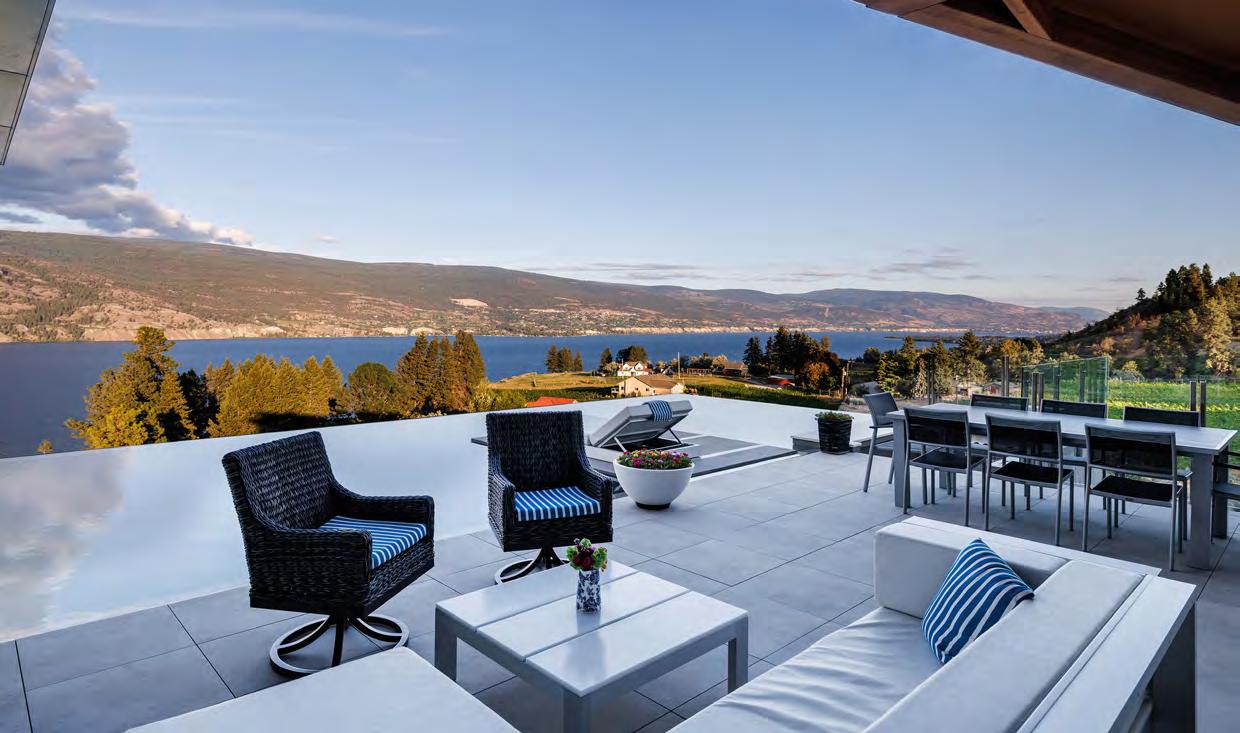
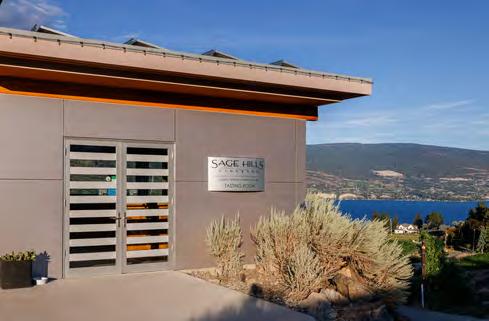
charcuterie delights. Across the horizon, a newly erected 80-by-40-foot two-storey outbuilding beckons with versatility, designed for accommodations, storage and expanded winery operations.
The vineyards, a testament to organic farming principles, steer clear of synthetic chemicals.
“It was thanks to my youngest son, Keenan, who became a winemaker in 2018, that we ventured down the natural-winemaking path,” says Rick.
The 10 acres of Pinot Noir, Gewürztraminer and Pinot Gris grapes benefit from drip irrigation for precision. Sage Hills pioneers as one of the first net-zero wineries in the Okanagan Valley, crafting 100 per cent vegan wines.
While this property stands as a paragon of perfection for those with a discerning eye, its allure extends beyond its boutique charm. It beckons visionaries to seize the opportunity to expand operations and imprint their unique identity upon it.
As Rick and Toby get ready to embark on a new chapter, the legacy they leave behind is a true testament to their vision and commitment. I joke with Rick that he’s done all the hard work, now someone can just come in and reap the benefits.
“You’re not wrong,” he says.
Sage Hills stands not just as a home but as a living ode to the organic harmony between architecture, nature and the art of winemaking.
Further details on the Sage Hills Winery listing are available through Nate Cassie, Hall Cassie Real Estate Group, Angell Hasman & Associates Realty Okanagan, 250-869-7995
Architect: DGBK
Interior design/cabinetry: Redl Kitchen Studio
Structural engineer: Eric Karsh
Contractor: Brian Moberg
Windows: Competition Glass
Plumbing/HVAC: GPH Mechanical
Electrical: Canyon Electric Company Inc.
Masonry: Shaun’s Masonry
Roofing and siding: Premium Roofing Ltd.
Countertops: Custom Granite Works Inc.
Light fixtures: ROBINSON Lighting & Bath
Tile supply: Stone Tile Pacific
Concrete: Scott Concrete and Scottsdale Concrete
Hardscape: Toby Thrussell
Solar: Swiss Solar Tech
Geothermal: Geotility
Vineyard tanks: Ripley Stainless Ltd.
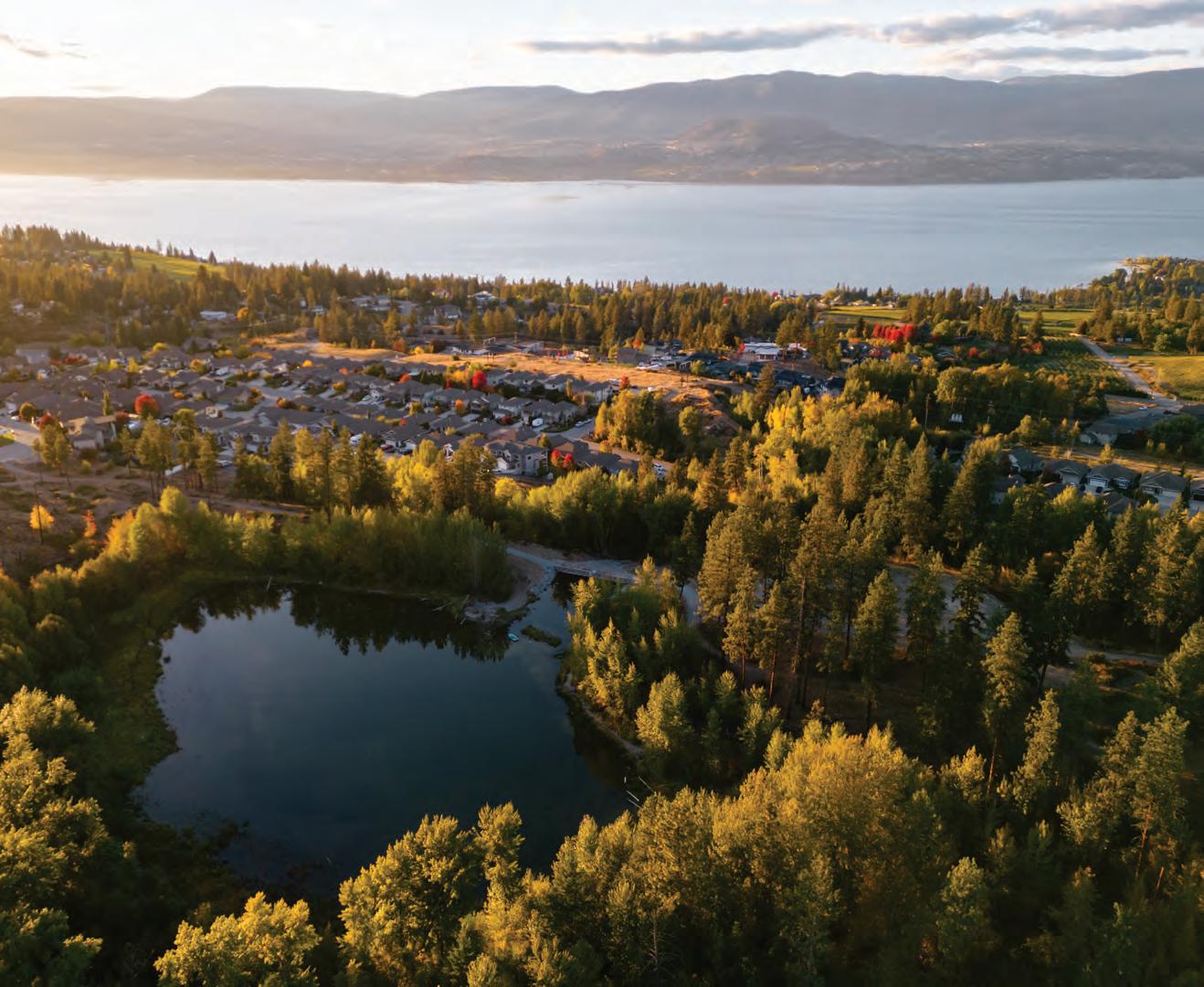

NATURE INSPIRED LIVING
NOW SELLING IN KELOWNA’S UPPER MISSION NEIGHBOURHOOD
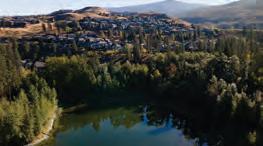
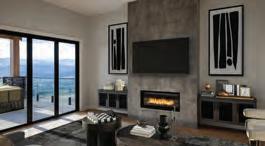
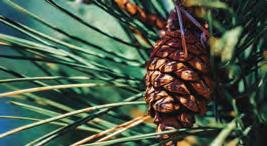
Nestled into the mountain hillside of Kelowna’s Upper Mission neighbourhood, Sage Water is steeped in history and rich in memory making. This is a place where wetland exploration comes naturally, and wildlife trails stand as a testament to the connection between the people and wildlife who enjoy this land to the fullest extent.
 On Blue: “Porto” chain ($419) by Lizzie Fortunato and “The Treasures of Fortunato” gold earrings ($350) by Pamela Card: both from Bernstein & Gold; orange ruched top ($40) by Levi’s from Turnabout.
On Jet: Large ammolite fully bezel set in 18K yellow gold ($4,495) from Idar Jewellers; Yellow TNA cashmere sweater ($70) from Turnabout.
On Blue: “Porto” chain ($419) by Lizzie Fortunato and “The Treasures of Fortunato” gold earrings ($350) by Pamela Card: both from Bernstein & Gold; orange ruched top ($40) by Levi’s from Turnabout.
On Jet: Large ammolite fully bezel set in 18K yellow gold ($4,495) from Idar Jewellers; Yellow TNA cashmere sweater ($70) from Turnabout.

Expression purely for your own delight. No longer trying to fit in or striving to be ideal for another person. Lean into self-love this season with makeup and jewellery that simply gives you pleasure to wear.
Photos by Lia Crowe Styling by Jen Evans Makeup by Jen Clark
Models: Blue Engelland Swift, Jet William Swift, Solange Lyons, Zen May, Halle Jean March, Navneet Kahlon, Milena Ludwig and Vellar Zhou.
On Solange: Glacier Bay earrings ($279), Vizcaya necklace in mint ($735) both by Lizzie Fortunato, and turquoise and silver ring ($99), all from Bernstein & Gold; completely handmade pendant in 18K yellow gold and 19K white gold with one 2.08 carat Paraiba tourmaline, double claw set and one 0.12 carat diamond ($14,895) from Idar Jewellers; pink cashmere scarf ($80) by Extreme Cashmere from Turnabout.


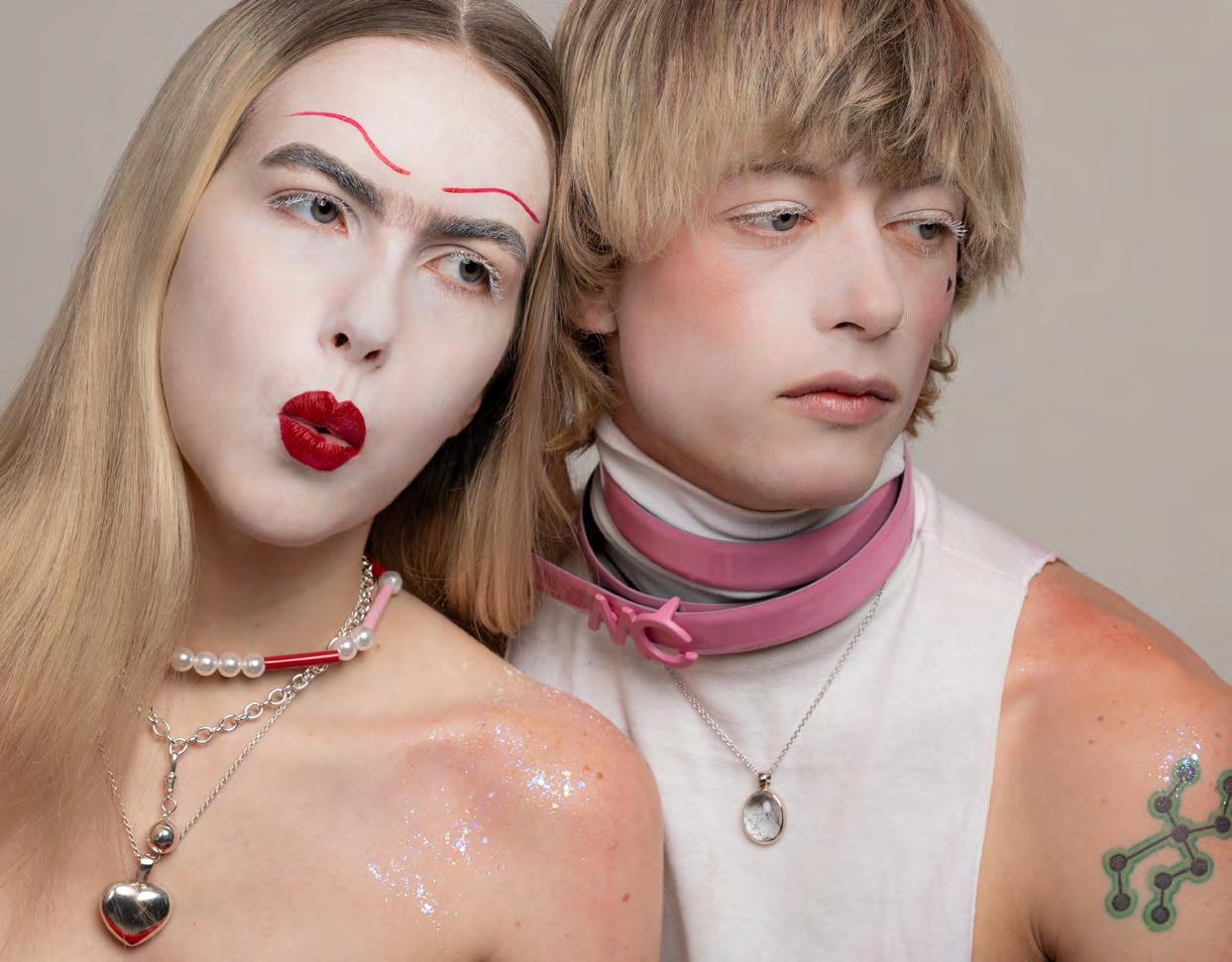
On Halle: Molten Baroque necklace in silver ($500) by Pamela Card from Bernstein & Gold. Heart and pearl necklaces (model’s own).
On Zen: Quartz with tourmaline needles, cabochon-cut, fully bezel set in 19K white gold, ($2,895), Marc Cain pink leather belt ($199), from Hughes Clothing.
On Nav: Lightning Bolt cashmere sweater ($599) by BRODIE, from Hughes Clothing.
Three True Round Thinline x Great Gardens of the World watches by RADO Switzerland ($2,800 each), from rado.com.


On Melina: Faceted pearshaped emerald, 0.64 carat weight, fully bezel set in 14K yellow gold ($3,295) on a yellow gold “Rolo Chain;” halo-style pendant set with 4.19 carat green tourmaline and 0.31 total carat weight diamonds, set in 18K white gold ($7,495); diamond drop earrings set in 18K white gold, top diamonds are 0.24 carat each and are Canadian, the bottom diamonds are 0.40 carat each ($9,995), all from Idar Jewellers.

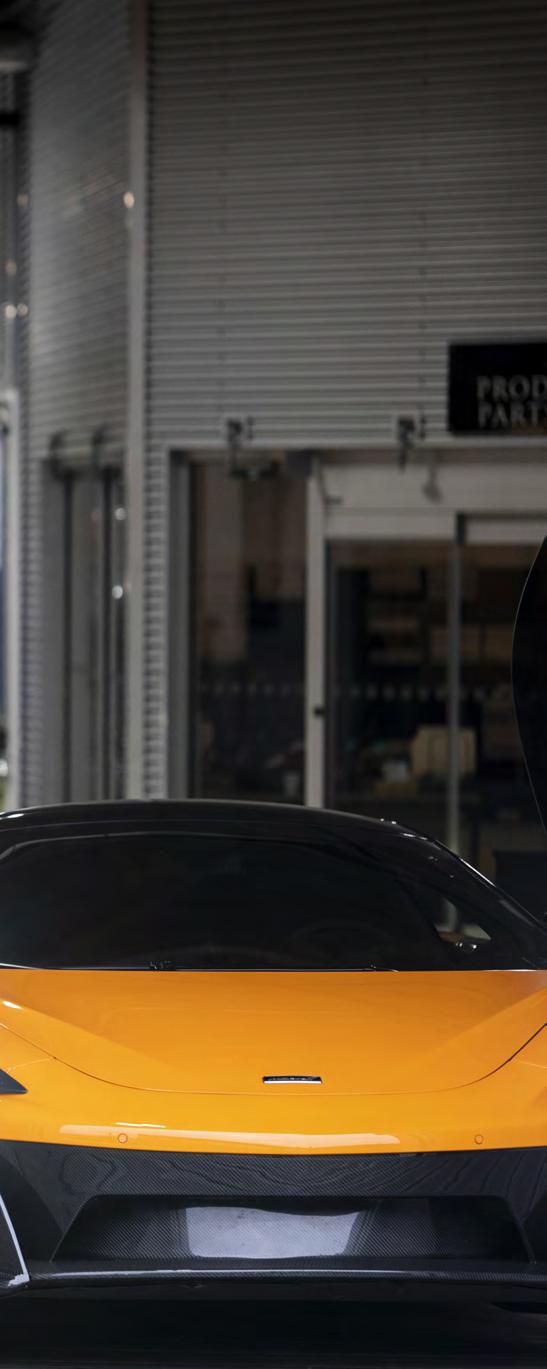
When brothers Scott and Rob Walker purchased a collision centre in Vancouver back in 1993, the two car enthusiasts knew they wanted to transform and elevate the concept.
“Most people think of a collision shop as dingy and dirty,” says Scott, 50, president of No.1 Collision Group. “We wanted to focus on luxury vehicles and become the ‘Chanel’ of the industry. We envisioned a luxury, concierge-type service with both a wow factor and a customer-oriented approach.”
The pair didn’t know it back then, but their timing could not have been better. Luxury brands—outside the very niche section of a market dominated by more common brands like Toyota, Honda and Hyundai—were on the cusp of exponential growth. In part that was driven by the arrival of Asian immigrants from Hong Kong and mainland China, who created a new demand for luxury vehicles.
“You had BMW growing, and Lexus and Mercedes entering the marketplace. And with their growth came our growth,” says Rob, 52, CEO. “The demand was there for high-end collision shops.”
Today No.1 Collision Group has six facilities—five in the Lower Mainland and one in Bellingham, Washington, with a seventh in Newport Beach, California opening in late 2024. All the shops are strategically focused on luxury automotive manufacturers, specifically Ferrari, McLaren, Tesla, BMW, Audi, Porsche, Mercedes-Benz, Range Rover, Jaguar, Rolls-Royce and Lamborghini.
The company invests considerably in technician training, and collision repair technicians are instructed in specific luxury brands. That means there are no generalists at No.1 Collision Group.
“We want our technicians to know specific brands inside and out, because you can’t do every brand and still do it well,” Scott says.
The company’s flagship location in Richmond, built nine years ago, feels more like a showroom than a collision repair facility. Designed by Vancouver architect Christopher Bozyk, the building is composed of concrete, steel and glass, with modern, minimalistic decor. Multiple large television panels showcase the company’s work and reflect a professional, upscale ambience that inspires confidence. There are no partly disassembled, crumpled cars in view, nor are there any technicians in greasy overalls visible. All the automotive repairs occur in a different section of the facility.
“Branding and image is huge to us,” Scott explains. “We want all our buildings to be timeless so that 50 years from now, they are still relevant. We offer a repair experience that is truly bespoke, and where things are done quite differently from many of our competitors. Take communication, for example, a big downfall in the industry. We have a ‘body shop booster software,’ wherein we use personalized text and email messages to let our clients know exactly what is happening with their vehicles.”
The bottom line, he adds, is about giving the customer a good experience.
“Our customers like coming here because we give them good quality automotive repair. Rob and I are proud of what we do—but it all starts with us being car enthusiasts.”
The Walker brothers are excited about their Newport Beach store, and they are confident that the company’s growth lies south of the Canadian border.
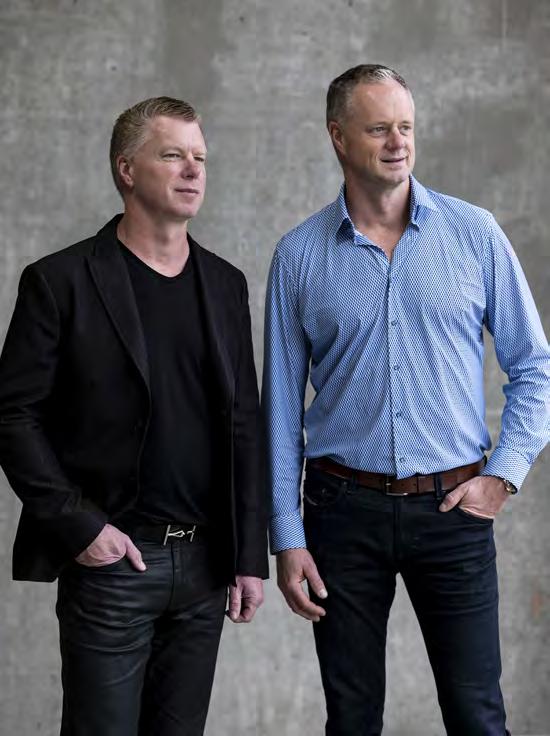
“Most people think of a collision shop as dingy and dirty. We wanted to focus on luxury vehicles and become the ‘Chanel’ of the industry.”
“We’ve saturated the Vancouver area,” says Rob. “But our growth model is slow because we want to do ground-up construction, which can take five to six years to complete—and that’s only after you’ve found the right site for a business.”
Proud of what they’ve accomplished to date, they describe No.1 Collision Group as the “Four Seasons Hotel” of the collision-repair industry, and are confident that among their clients, they’ve completely changed the image and perception of the industry. As they eye future growth, they admit their success has a lot to do with timing.
“We were lucky with our timing back in the early 1990s, when the luxury automotive market in Vancouver was starting its growth. We helped put some of the pieces together, and the result was magic.”

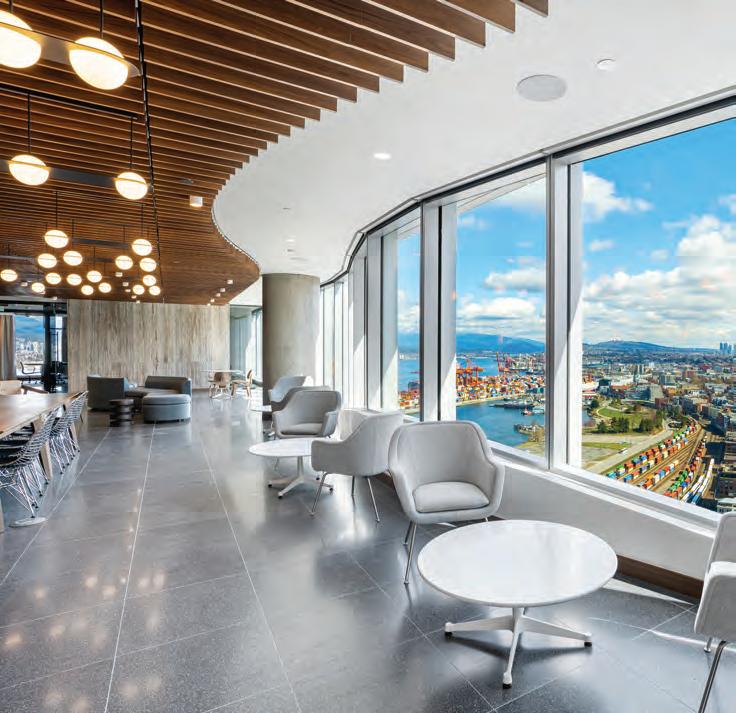

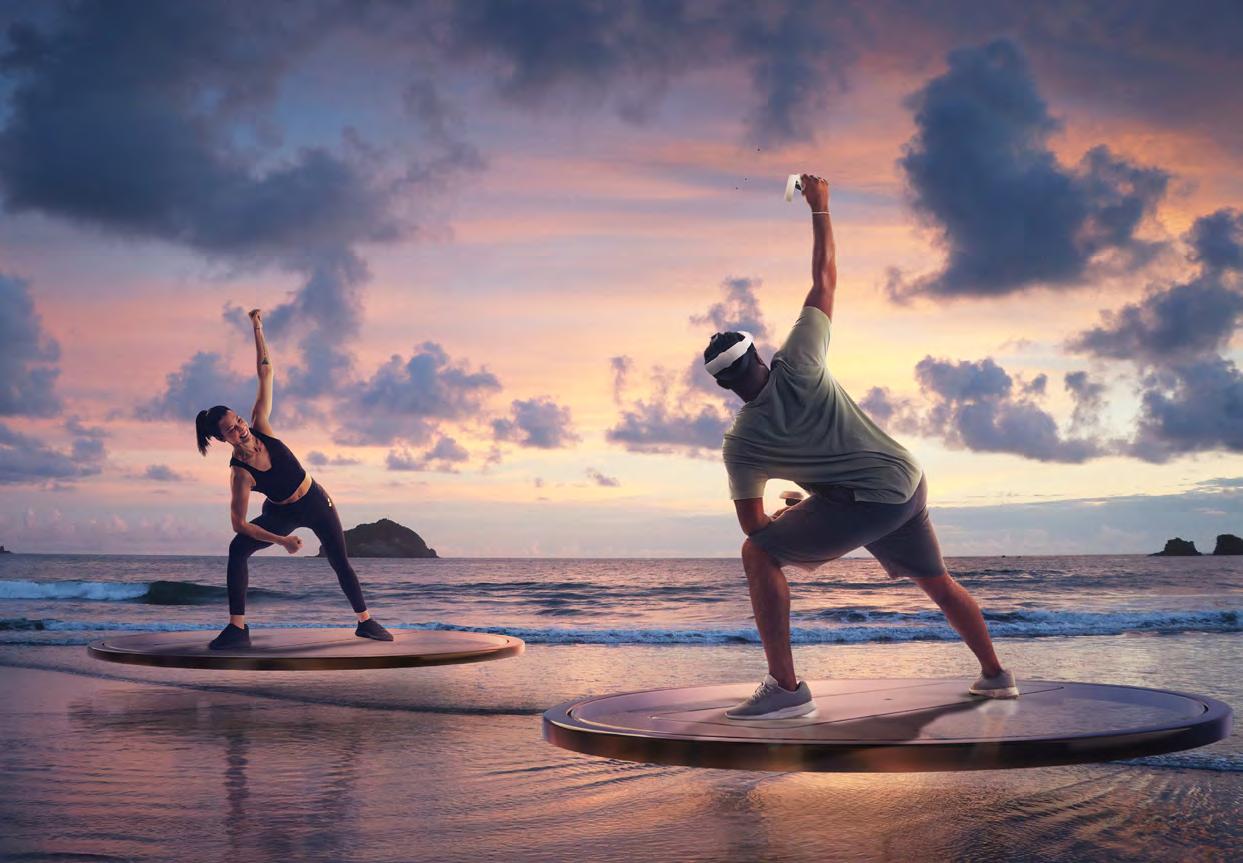
The world of wellness
Everything from virtual reality fitness workouts to cold plunging and superfoods are on trend for 2024
WORDS LAURA GOLDSTEIN

WHAT’S TRENDING IN 2024? QUALITY OF LIFE THROUGH SCIENCE AND INNOVATION WITH AN INCREASED FOCUS ON SOCIAL CONNECTIONS ARE TOP PRIORITIES THIS YEAR. ACCORDING TO THE DATAGATHERING COMPANY STATISTA, CANADIANS ARE PROJECTED TO SPEND $4.13 BILLION ON SELF-CARE IN 2024. HERE’S A LOOK AT WHAT’S HOT IN THE WELLNESS WORLD.
Imagine practicing yoga in the Himalayas or kickboxing on Mars—all from the comfort of your living room. Wearable technology advancements will play a crucial role in fitness regimes in 2024.
Touted as “the anywhere workout,” Supernatural—a subscription-based virtual reality (VR) fitness app by Within—pairs with the Meta Quest 2 VR headset for immersive workouts. With the help of a virtual trainer, you can challenge yourself with high-intensity exercise, or meditate in your own world of calm.
See getsupernatural.com
Apple’s Vision Pro, a mixed-reality headset launching in the US in February (and coming to Canada later in 2024), enables the wearer to watch movies, capture videos and multitask. Fitness apps are in the works, including a yoga app that uses the device’s cameras to measure breathing.
Apple has already launched Fitness+ with Strength, Core and Yoga for Golfers, featuring and designed by pro golfer phenom Rose Zhang, and led by Canadian fitness and core trainer Kyle Ardill. Available by subscription on Apple Watch, iPhone and Apple TV.
SEE APPLE.COM/APPLE-VISION-PRO
Seaweed continues to trend this year and not just as a superfood: it is also valued for its hydrating, anti-aging properties. Vancouver Island’s thalassic skincare company Seaflora has been hailed as offering the world’s first USDACertified organic skincare line.
Founded in 1998 by Sooke-based Diane Bernard, the company is overseen by her son, director Adam Butcher and his wife, Chantelle Line, who is the marketing manager.
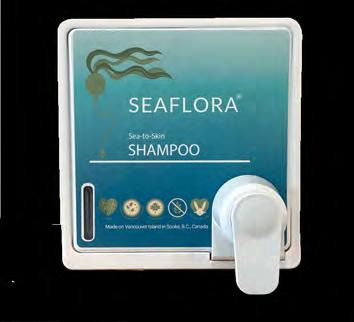
“Seaweed comprises 80 per cent of all our products, including our new natural Sun Shield facial moisturizers,” says Chantelle. “Clean beauty is thriving and not just by paying attention to what’s inside the bottle. By 2025, the luxury hotel group Relais & Chateaux is going eco and doing away with all plastics in their hotel-room amenities worldwide.”
In anticipation of sustainable-packaging needs, Seaflora has created a new shower and bath amenity dispenser, already popular at Black Rock Oceanfront Resort and Drift Spa in Ucluelet.
“It dispenses Seaflora products in a single model for hand soap, double for shampoo and conditioner or triple including body wash. All affix to the wall. They are available in a variety of colours but all ‘green,’” laughs Chantelle.
SEE SEAFLORASKINCARE.COM



Canada Goose




Whatever your choice of self-care and wellness trends this year, longevity and aging gracefully are the ultimate goals.

While most of us are familiar with indoor saunas, a company based in Squamish is bringing barrel saunas to backyards across North America.
“It’s such a unique shape that doesn’t compete with a home’s architecture or their property, whether it’s in their backyard, chalet or cottage,” says co-founder and engineer Kris Harris of Nootka Saunas. “Whether it’s for a quiet, healthy meditation part of your day or a social component with friends after dinner, backyard saunas have become increasingly popular.”
Kris grew up in Ottawa with its bracing cold winters and often enjoyed a sauna, followed by cold plunging through a hole cut in lake ice at a friend’s cottage. But it was when he travelled to Finland, Sweden and Norway in 2016 that he
decided to bring the wellness sauna culture to North America.
“Traditionally, saunas have been wood-burning, but we also offer electric, and the convenience of just pushing a button, and then 10 to 15 minutes later it’s at 90 degrees Celsius,” he explains. “Whereas wood-burning takes a bit longer to get it stoked, they are both very safe (CSA approved) and the heat of an electric sauna is very comparable to a wood-burning one.”
With its western red cedar wood (which smells wonderful) milled locally, the cylindrical, barrel-shaped sauna comes in eight-foot and 10-foot sizes, makes for excellent air flow and is easily installed on any level surface, including gravel, crushed stone, wood decking or flagstone.
SEE NOOTKASAUNAS.COM
Cold plunging is one of the biggest wellness trends for 2024. If you’re a fan of the reality TV show Shark Tank, you might have watched Canadian IT entrepreneur Robert Herjavec submerging in a tub of icy cold water designed by California company PLUNGE. He did not go in quietly but ended up investing $2.4 million in the start-up.
Professional athletes are no strangers to cold-water therapy and ice baths, which are said to reduce muscle swelling, pain and stress by constricting the blood vessels. Popularity has now exploded among fitness enthusiasts in general.
Cold-plunge tubs are made of acrylic and fibreglass and come in different shapes and sizes. Temperature controlled water can cool down to a chilly 2 degrees Celsius and the tub can be installed indoors or outdoors. PLUNGE tubs have a powerful cooling, sanitation and filtration system with continuous water circulation and easy set-up that plugs into an electrical socket.
PLUNGE has partnered with the Wellness

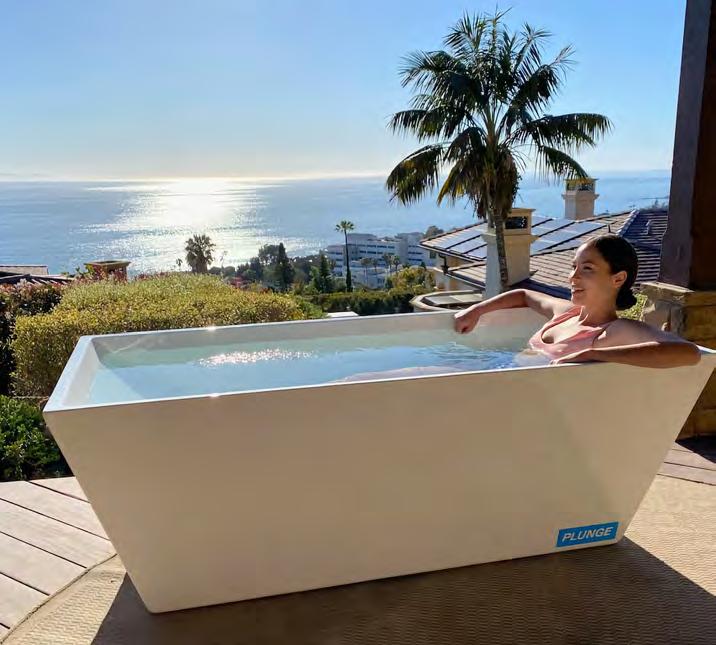
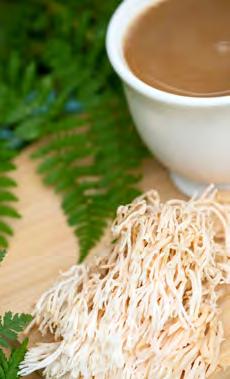
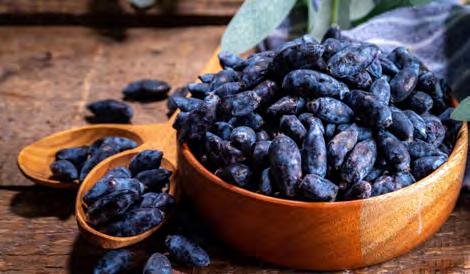
What do haskap berries, lion’s mane and cacao pulp have in common? They are part of an even bigger swing by consumers toward plant-based foods, flavours and drinks.
Each year, Whole Foods’ Trends Council—a team of over 50 culinary experts, foragers and buyers—forecasts new and healthy food trends to entice the health-conscious consumer. Here’s what they predict:
• Buckwheat, naturally gluten-free and high in protein, will be everywhere, from crackers to milk-based alternatives.
• Cacao—yes, it’s the fruit of your favourite chocolate bar, but did you know there is a diverse use for cacao? North America is discovering this previously discarded pulp, which is now being made into jams and jellies.
• Also be on the lookout for haskap berries in 2024. Already heralded in Japan as “the elixir of life,” the dark purple, elongated fruit, which tastes similar to blueberries, has four times the antioxidants.
• Lion’s mane mushroom has been studied for its cognitive benefits including improved memory and boosting non-jittery energy. Made into a powder, it gives coffee a nutty, earthy flavour. California wellness brand Clevr’s blended mushroom coffee and tea starter kit includes two different mushroom lattes and is on “Oprah’s Favourite Things” for 2024.
Whatever your choice of self-care and wellness trends this year, longevity and aging gracefully are the ultimate goals.
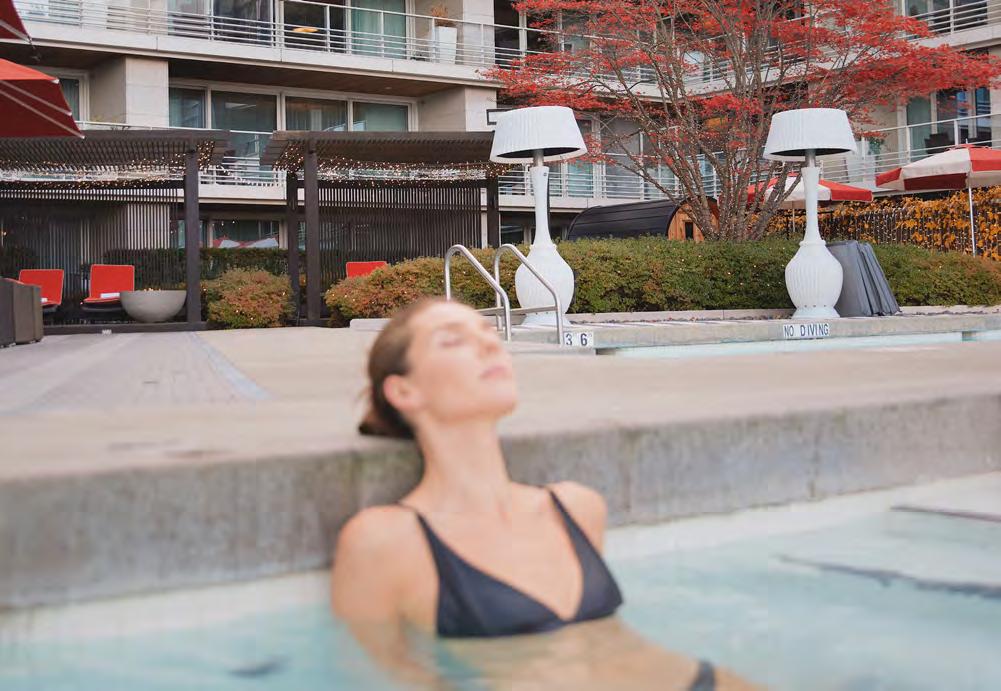
Nordic countries have been doing it for 2,000 years. Amid long, dark winters, saunas and cold-water plunging are communal activities that have proven to lower seasonal depression, help muscle and joint pain relief and give an overall boost to full-body rejuvenation. Canadians, who share an affinity with the Nordic climate, are finally embracing this wellness trend. But what’s taken us so long?
It may be because a sauna followed by ice bathing or rolling in the snow (yes, that’s a real thing) start early and are considered family activities in the Nordic countries, and so they become part of life at a young age.
I’m ready to give it a try at Fairmont Pacific Rim’s new outdoor Nordic spa experience. It’s 8 degrees Celsius outside and
drizzling, and I feel like I’m dressed for an expedition to the Arctic: bathing suit and spa robe under a provided parka with a hood, and holding an umbrella. I’m slightly embarrassed as the weather hasn’t deterred many diehards from frolicking in the hotel’s outdoor heated pool and hot tub. I decide to make a dash for the sauna.
Ah, the cedar-scented air is delightful, and I’ve even stripped down to my bathing suit!
Designed and built by Squamish company Nootka Saunas (see related story), the sauna resembles a gigantic cedar-plank barrel: think hobbit house with a higher ceiling. By pushing a button, it heats up electrically—something I’ve never experienced before in a sauna. The heat is much drier than that
produced by more traditional wood-fired saunas, which use igneous or volcanic rocks and water from a bucket to increase the steam and humidity.
After about 10 minutes in the sauna, I gather my courage and decide to take the invigorating cold plunge.
This is one situation in which double-dipping is de rigueur. I watch a husband and wife who jump and completely submerge into two deep acrylic and fiberglass tubs filled with cold water and then head back into the sauna—twice. Looks simple enough.
Yikes! Full disclosure: I dipped up to my knees instead of plunging. The circulating water temperature is about 10 to 15 degrees Celsius and I jumped out in 20 seconds. Oh, why didn’t I keep my parka on? Deciding to reward myself for bravery, I make a beeline for the loungers to order bone broth and a warm truffle grilled cheese sandwich, the ideal comfort foods from the menu designed by Fairmont Pacific Rim’s executive chef, Damon Campbell.
“Norway, with a population of five million, has something like three million saunas, many inside their homes,” says Fairmont Pacific Rim spa director Kim Carmichael. “Although we’re nowhere near that in Canada, it’s starting to become far more prevalent and trendier in North America as people discover the health benefits of a Nordic spa.”
She adds, “We’ve really been inspired by the Nordic countries making the experience inviting.”
(Unlike the Nordic countries, however, The Nordic Spa at the Fairmont Pacific Rim is limited to those aged 13 and over.)
When the self-guided Nordic spa experience outdoors on the hotel’s sixth floor was designed, the hot tub and heated pool already existed. So, by adding the sauna and cold plunge tubs a circuit of restorative activities has been created.
“It’s recommended to start with the sauna for about 15 minutes, and then step into the full cold plunge for anywhere from a minute to three minutes or longer if you can handle it. Then alternate between the heated pool and hot tub and then start the whole circuit again,” Kim explains.
Open from 8 am to 9:30 pm daily, guests can relax on sofa loungers under a canopy of oversized patio umbrellas, sip on green tea or hot chocolate and warm up alongside heaters and fire pits, surrounded by harbour and mountain views.
In addition to The Nordic Spa experience, one-hour yoga classes are offered poolside twice a week. There is also access to the holistic Willow Stream Spa amenities, including a mineral bath, steam rooms and hydrotherapy showers, among other treatments. All are open to the public as well as hotel guests. Prices and upgrades vary, and reservations are required.
“I think overall, people are looking to experience how to live better and longer. I like to think of Fairmont Pacific Rim’s Nordic Spa as an oasis in the city to do just that,” Kim says.



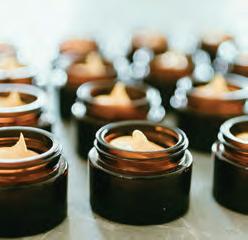


The discipline of self-care
Meal-plan

Eating well. To me, this means eating delicious and healthy foods, and regularly feeling nourished and satisfied. Achieving this is possible, but it often means doing the tasks we least want to do, rather than letting ourselves off the hook.
A late-night session with a tub of ice cream is sometimes exactly what we need, but more often than not, what we actually need is the “discipline of self-care.” This means that the default is not to treat ourselves but to take care of ourselves, making true self-care a priority with a focus on long-term goals over short-term gratification.

A late-night session with a tub of ice cream is sometimes exactly what we need, but more often than not, what we actually need is the “discipline of self-care.” This means that the default is not to treat ourselves but to take care of ourselves, making true self-care a priority with a focus on long-term goals over short-term gratification.
In terms of food, this means following a balanced self-care plan involving more discipline than indulgence. We must build structures, habits and plans that will improve the overall quality of our lives and help us to prioritize our desire to eat well and feel healthy.
Below are some ideas and some delicious recipes that will make it easier to eat well, every day—or do so as best we can.
When it comes to healthy eating, and eating well, I use several different strategies, with flexible applications: stocking the pantry; meal planning; meal prepping; and, making nutritious foods more appealing and delicious.
Stocking the pantry generally is the easiest of the four. But making adequate use of our well-stocked pantry is where the discipline of self-care comes in. This is why meal-planning and meal-prepping strategies are the pillars of my eating style.
These are two arms of a similar concept. Planning “what’s for dinner” ahead of time is a game changer! You know what’s for dinner and you have made sure the ingredients are on hand. No need to make a decision when you are tired after work. Meal prepping takes this to the next level: you spent time and energy on the weekend prepping and pre-cooking parts of those planned meals to make weekday life even smoother and easier.
It’s important to start with what is most achievable. Meal prepping is more difficult than meal planning and you may decide that it is not the best use of your time off. Or you may come to meal prep gradually, after months of incorporating meal planning and pantry stocking into your weekly life. Start small; don’t overreach. Include take-out and meal prep kits in the plan, if that is what works best for you. Whatever it takes to feel good about what you are eating.
I use a mix of meal planning and meal prepping for my busy life. I always meal plan, and specifically plan for leftovers, but I
don’t always set aside time on a Sunday for actual meal prep. Given our busy schedules, I know to plan for, and shop for, no more than three family dinners per week. And we make sure to cook extra on each of those dinners so that there are always leftovers ready for lunches or dinners on the go.
If I’m making salad for dinner, I double the salad dressing and use half of it to marinate canned beans or lentils for some mealprep salads. I plan for Monday night’s spiced chicken to be made in a two-kilogram batch, so that I am closer to having healthy lunches or dinners the rest of the week with these delicious “plan-overs.”
This rolls both meal planning and meal prepping into one adaptable workflow. If I have the time to meal prep on Sundays, excellent. If not, I have already incorporated meal prep into my life with big-batch cooking.
Making healthy foods more appealing is icing on the cake. My flavourful and fresh recipes below can be a springboard of inspiration. I love having a meal plan in place and having healthy yummy food ready-to-eat in the fridge. Hopefully, with these ideas and recipes, you can too.
Makes 3 pre-prepped lunches.
This salad is delicious, quick to make, and perfect as a lunch-to-go. The higher acid content of this dressing helps the starchy beans to shine.
1 can bean medley (mixed beans), approx. 400 ml to 500 ml 1 clove garlic, pressed through a garlic press, or minced very fine 5 ml (1 tsp) salt
45 ml (3 tbsp) white wine vinegar or cider vinegar
45 ml (3 tbsp) extra virgin olive oil
2.5 ml (½ tsp) freshly ground black pepper
2.5 ml (½ tsp) granulated sugar
2.5 ml (½ tsp) dried oregano leaves, crushed in your fingers
Three 500-ml wide-mouth mason jars, or containers of similar size ¼ red onion, thinly sliced or minced
90 ml (6 tbsp) crumbled feta cheese
750 ml (3 cups) chopped raw vegetables (cherry tomato, cucumber, radish, bell pepper)
375 ml (½ cup) shredded spinach leaves or lettuce leaves
Optional 90 ml (6 tbsp) minced fresh parsley
Marinated Beans: Open the can of beans and pour into a sieve over the sink. Rinse and drain well and place into a mixing bowl. Add the garlic, salt, oil, vinegar, pepper, sugar and oregano. Mix well. Let sit, stirring occasionally.
Salad prep: Divide the marinated beans between three mason jars, along with all of the marinade. Try to get an even amount of marinade into each jar. Top each set of beans with an equal amount of sliced or minced red onion. Top each with 2 tbsp of crumbled feta. Then add 1 cup of chopped mixed vegetables to each jar. Finally, top each with about half a cup of shredded spinach or lettuce. Close the mason jars and place in the fridge.
These last for about four days in the fridge. When you are ready to eat, take out a jar and dump into a bowl, making sure to get every last bit of marinade. Mix well and enjoy!
Ingredients:
Serves 2
2x 150g portions of Wild BC Halibut, skin removed
200 g Saltspring Mussels
1 bunch swiss chard, largest leaves possible
3 Tbsp + 1 Tbsp olive oil
2 shallots, thinly sliced (approx. ¾ cup)
1 Tbsp + 1 tsp crushed garlic
3 tsp kosher salt
2 cups sliced mushrooms
3 cups Finest At Sea fish stock
150 g pappardelle
Zest of 1 lemon
1/3 cup chopped parsley
Pepper to taste
*4 x 25cm lengths of butcher’s twine
Directions:

• Bring a small pot of water to a gentle boil.
Check ourforwebsite more greatrecipesseafood
• Pull the stems off the swiss chard, thinly slice and set aside. Blanch the leaves for 30 seconds, remove and cool quickly in cold water.
• Fill the pot with fresh water and cook pasta for 1 minute less than package directions. Strain, rinse, toss with remaining Tbsp of olive oil.
• In a medium pan over medium heat, sauté the shallots in 3 Tbsp of olive oil. Once translucent, add 1 Tbsp garlic and cook 1 min longer. Add mushrooms & chard stems, cook until tender. Remove from the heat and allow to cool.
• Divide chard leaves in 2 and lay flat to create 2 sheets of leaves, about 3 times the size of each halibut portion. If the leaves are smaller, overlap them to create 2 large sheets.
• Divide the mushroom mixture into 3 parts. Divide 2/3 of the mixture between the 2 chard sheets, top with halibut potions & season generously with kosher salt and pepper. Wrap the chard sheets around your halibut and tie each bundle with 2 pieces of twine.
• Bring the fish stock to a gentle simmer in a high-sided sauce pan. Season with remaining tsp of crushed garlic and a tsp of kosher salt.
• Gently place the halibut bundles in the simmering stock and cook covered for 6-8 mins, depending on the thickness of the fillets. If the stock level doesn’t completely cover the bundles, flip over half way through cooking. When halibut is cooked, remove from stock.
• Put remaining 1/3 of mushroom mixture in the stock with mussels & the pasta. Cook until mussels pop open. Add lemon zest & parsley. Serve in a bowl with all the broth, topped with poached halibut.
Serves 8 to 10
This tender, flavourful chicken works as a main dish protein, as well as for use in other planned meals. My favourite ways to use this spiced chicken as “planovers” are in a gingery salad and in a wrap.
MARINADE
125 ml (½ cup) vegetable oil
82 ml (1⁄3 cup) lemon juice
7.5 ml (1½ tsp) salt
5 ml (1 tsp) sugar
2 cloves garlic, grated or finely minced
10 ml (2 tsp) grated or minced fresh ginger
15 ml (1 tbsp) garam masala
15 ml (1 tbsp) ground turmeric
10 ml (2 tsp) paprika
10 ml (2 tsp) ground cumin
2.5 to 10 ml (½ tsp to 2 tsp) cayenne (depending on your desired spice level)
CHICKEN
1,300 g (3 lb) boneless skinless chicken breasts
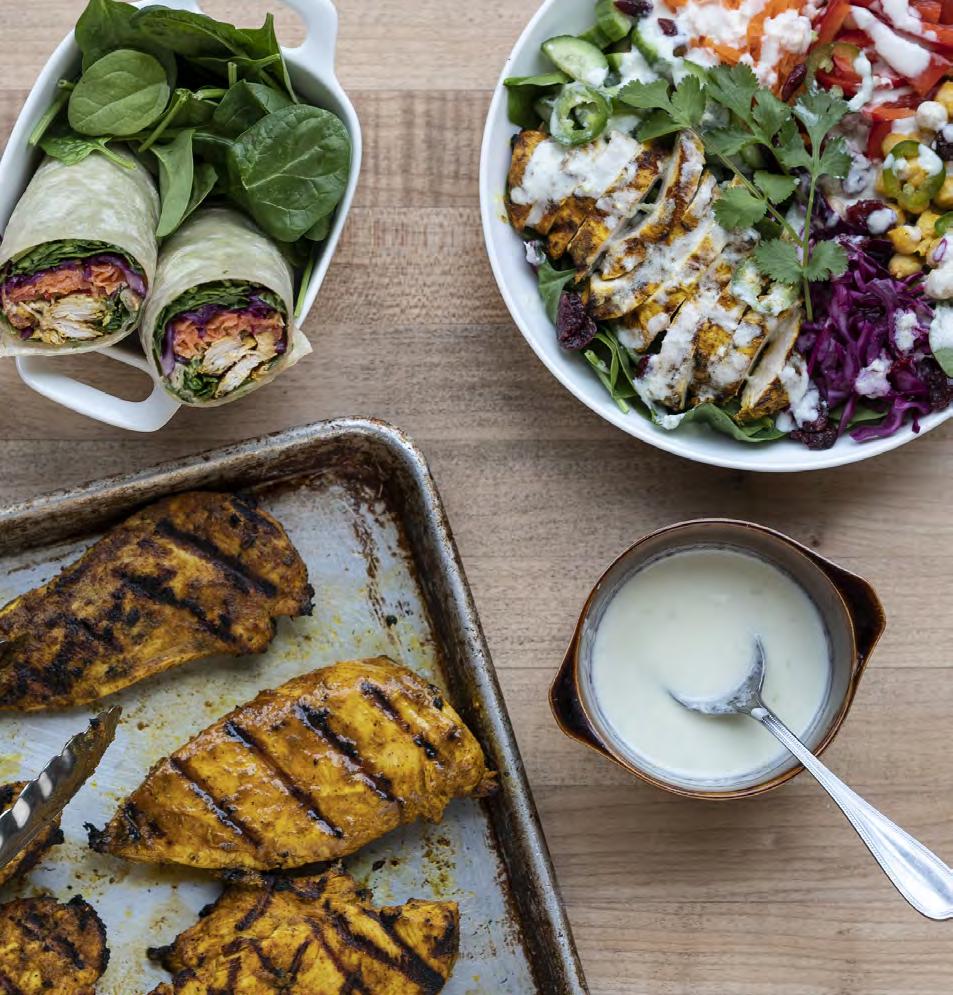
Marinade: Combine marinade ingredients in a large bowl and mix well. (If desired, scoop two tablespoons of this marinade into a mason jar for marinating chickpeas for a salad later in the week.)
Prepare chicken: If the chicken tender is present, remove this and place in the bowl with the marinade. With the remaining breast, slice the thick part of the breast in half (like a bagel) to make thinner cutlets. Cut the large piece in two. You will end up with three pieces of chicken breast that are approximately the same size and thickness. Place these in the bowl with the marinade. Proceed with the remaining chicken. The thinner cutlets will absorb the marinade more quickly, cook more quickly and spread out over more meals. Mix the chicken well so it is evenly coated with marinade. Marinate for at least 30 minutes and up to 2 hours. Don’t marinate for any longer because the high acid content can affect the texture of the chicken.
When ready to cook, drain chicken well and discard the marinade. You can bake this chicken in an air fryer set to 400 F, or grill it on a preheated grill for 3 to 4 minutes per side. Internal temperature of the chicken should register 165 F (74 C) on an instant reading thermometer when properly cooked.
Serve the first night with rice and veggies. Use leftovers as desired (salads, sandwiches, wraps, soups). Use the following recipes as a guide.
Serves 4
For a quick dinner or lunch-to-go, this recipe makes use of both the grilled chicken and the ginger dressing from the two previous recipes, for a great meal planning option.
Four 10- to 12-inch flour tortillas
Leftover Indian-spiced grilled chicken, chopped 1 to 1.5 litres (4 to 6 cups) assorted chopped or shredded vegetables (carrots, bell pepper, cabbage, spinach, cucumber)
60 to 90 ml (4 to 6 tbsp) ginger-yogurt dressing (previous recipe)
Thinly sliced jalapenos, if desired, OR pickled jalapenos Chopped cilantro leaves, if desired Salt, if desired
Heat the tortillas in a dry frying pan until pliable. Place 1 to 1.5 cups of shredded vegetables down the centre of each tortilla. Sprinkle with salt, if desired. Drizzle with ginger-yogurt dressing. Add chopped spiced chicken, sliced or pickled jalapenos (if desired) and chopped cilantro (if desired).
Roll tortillas tightly. Slice in half before eating.
Serves 4
This zesty creamy dressing can be used as a marinade for the chickpeas, as a salad dressing or as a sauce in a wrap. This salad can also be prepped in four mason jars, with the chickpeas, chicken and dressing on the bottom, and the veggies on top, for a planned lunch-to-go.
250 ml (1 cup) plain yogurt
125 ml (½ cup) freshly squeezed lemon juice
30 ml (2 tbsp) finely grated or minced ginger
60 ml (¼ cup) vegetable oil
7.5 ml (1½ tsp) salt
10 ml (2 tsp) sugar or honey
10 ml (2 tsp) finely minced jalapeno or ¼ tsp cayenne
SALAD
One 400- to 500-ml can of chickpeas, drained and rinsed 30 ml (2 tbsp) reserved marinade (see chicken recipe above)
4 to 8 pieces of leftover Indian-spiced grilled chicken
2 litres (8 cups) spinach leaves or mixed lettuce leaves
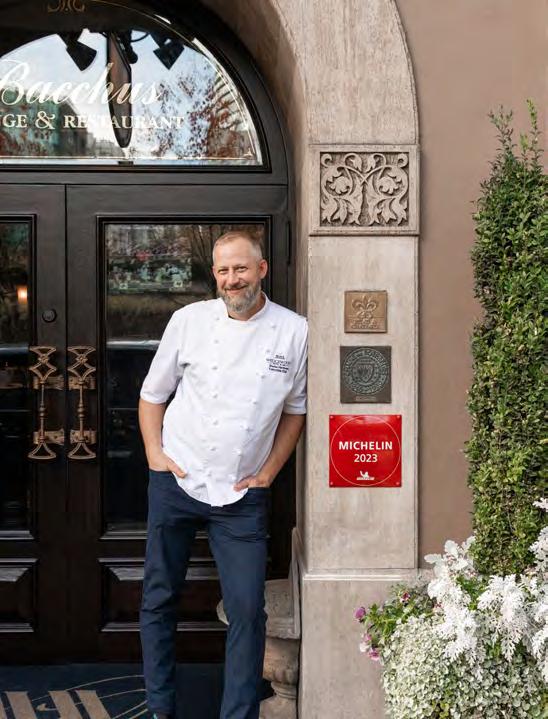
1 litre (4 cups) chopped raw vegetables (good options include grated carrot, shredded cabbage, chopped cucumber, sliced tomato, sliced green onion, sliced bell pepper) Optional 60 ml (¼ cup) sultana raisins or dried cranberries Cilantro leaves for garnish, if desired
Dressing: Combine all ingredients and whisk until smooth. Taste to adjust seasonings. Some yogurts are tarter than others, so you may need to adjust the acidity or sweetness with more lemon juice or sugar.
Chickpeas: If possible, the day before, rinse and drain the chickpeas and place in a mason jar with the reserved marinade (the 2 tablespoons you reserved BEFORE adding the chicken, see chicken recipe above). Close the lid and shake well. Place in the fridge and shake several times over the day until you are ready to use it. When close to serving time, add 2 to 3 tablespoons of the ginger-yogurt dressing to the chickpeas and shake well again.
Salad: Using 4 large soup bowls, divide the spinach or lettuce between the bowls. Divide the marinated chickpeas between the four bowls. Divide the prepped vegetables between the four bowls. Drizzle each bowl with some of the dressing. Slice up the chicken and divide it among the bowls. Scatter the raisins or dried cranberries over the top of each, if desired. Drizzle on some more of the dressing. Garnish with cilantro and serve.
Alternatively, layer this salad into 4 mason jars, with the chickpeas, chicken and dressing on the bottom, and the veggies on top, for planned lunches-to-go.


Tucked away inside the Wedgewood, visit MichelinRecommended Bacchus Restaurant and Lounge. Chef Stefan Hartmann blends his European finesse with local Pacific Northwest ingredients, setting the stage for a memorable dining experience in the heart of Vancouver. Make
845 Hornby Street, Downtown Vancouver wedgewoodhotel.com/dining/bacchus-restaurant/ +1 604 608 5319bacchus@wedgewoodhotel.com


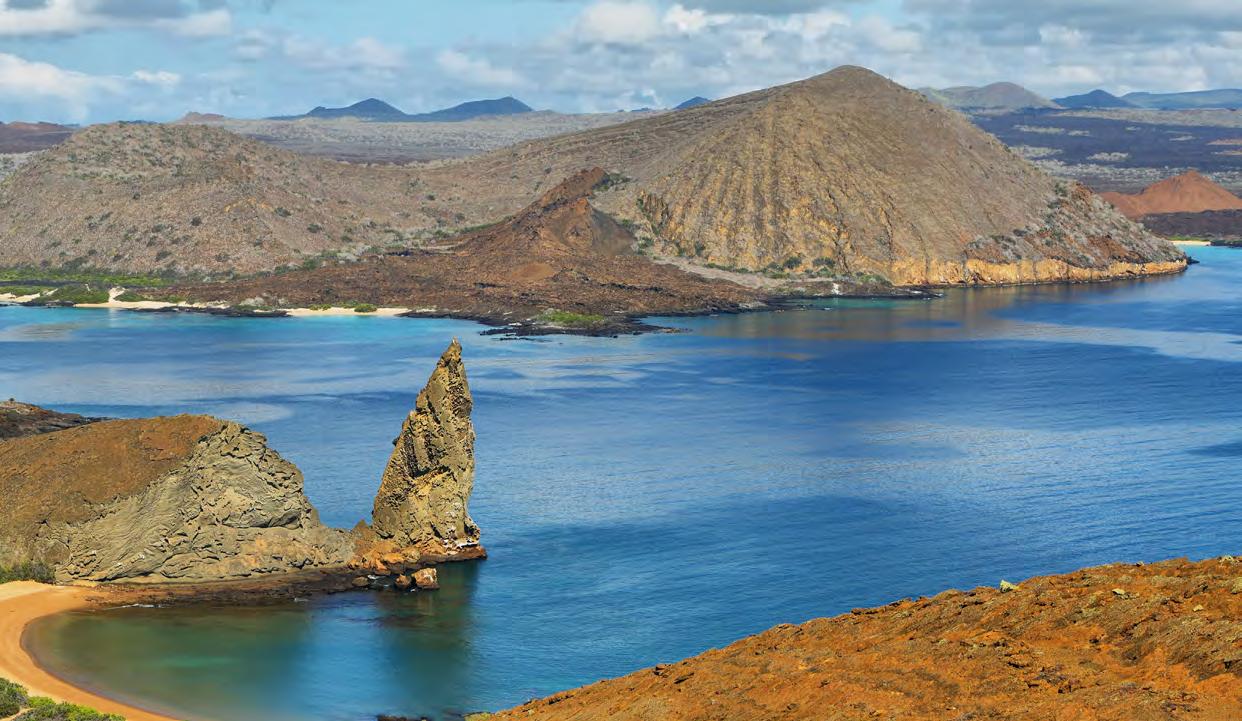
“The trip of a lifetime.” It’s a popular expression, but to me, it makes no sense. If a trip is that fantastic, then why not do it again?
Which is why my husband and I find ourselves in Galápagos 32 years after we first visited these enchanted islands that straddle the equator off the coast of Ecuador.
In 1991, Kit and I were budget travellers, backpacking around the world for a year. We arrived in Galápagos knowing only that we wanted to explore by small ship. We showed up at the dock in Puerto Ayora on the island of Santa Cruz, met a few others also waiting for a boat and grabbed the first one that came in.
Decades later, we still talk about that week: recalling the experiences of coming face-to-face underwater with sea lions, having our toes gently nibbled by curious penguins and meeting the largest tortoises on the planet.
We wanted a similar experience this time, but more upscale. A friend told me about a company based in Ecuador and owned by a Canadian who backpacked through South America and stayed in Galápagos at the end of her trip. Judy Carvalhal worked initially as a park naturalist, and then started her own business, Enchanted Expeditions, and helped pioneer tourism on these unique islands.
Today, Enchanted Expeditions operates three ships yearround in Galapagos. We chose to travel on the Cachalote Explorer. Built in Vancouver originally as a fishing boat, it was converted to a passenger vessel and for a few summers cruised along our west coast. After Galápagos purchased it, she gave it further upgrades to make it a “First Class” yacht.
At 88 feet, and accommodating just 16 passengers in eight cabins, each with private bath and air conditioning, it sounded just right.
Before boarding on our first day, we visited Rancho El Manzanillo, a farm on Santa Cruz where some of the islands’ 20,000 giant tortoises roam freely. If that seems like a lot, consider that before people arrived in Galápagos in 1535, there were 250,000 tortoises.
Their demise was rapid once sailors learned that a tortoise could stay alive for up to a year without food or water and provide fresh meat for crews.
So it was thrilling to see dozens wandering freely and—we couldn’t help but notice—procreating like crazy!
“He’s probably having a cigarette by now,” joked Bob, a guest from New Mexico, as we looked for one particularly large and lustful tortoise that we spotted earlier but had disappeared by the end of our walk. No problem, we’ll see lots more in the days ahead.
Aboard the ship that evening, we learned how the week would unfold. We were sailing what’s known as the Fernandina itinerary, through the western half of the Galápagos, with four excursions daily, two on land and two in the water, either snorkeling or kayaking.
Between outings, we’d enjoy Ecuadorian-style meals (lots of local fish, meat and veggies, with spicy salsas on the side), snacks on deck (fresh fruit and empanadas), post-prandial naps on chaise lounges on the upper deck, and pre-dinner drinks in the lounge while oohing and aahing over each other’s photos from the day.
Decades later, we still talk about that week: recalling the experiences of coming face-to-face underwater with sea lions, having our toes gently nibbled by curious penguins and meeting the largest tortoises on the planet.

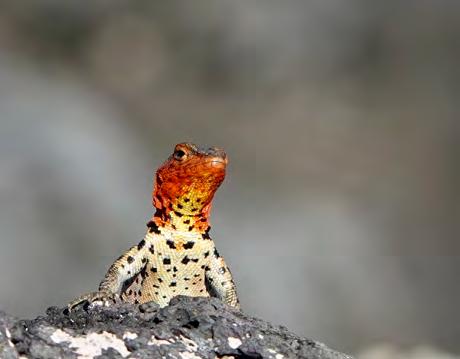
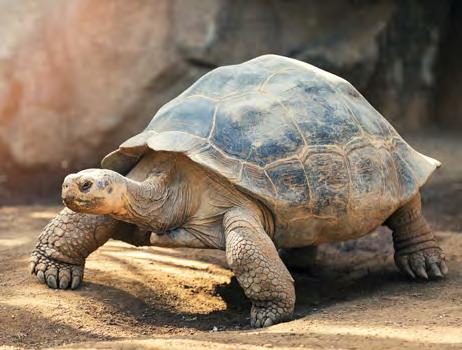
While we drifted off to sleep each night, our captain moved our ship to a different location, so we awoke to a new view each morning. Sometimes it was a vision one of misty summits and lush vegetation, but more often than not, it was black lava studded with cactus and the distinctive cone of one or more volcanos in the distance.
Galápagos is one of the most volcanically active places on the planet. Some of the landscape is so raw, you wonder how anything lives here. Yet this archipelago of 19 islands and surrounding water—the Galápagos Marine Reserve—is home to about 9,000 species. The reason there’s so much life is simple. The islands lie in the path of five nutrient-rich ocean currents, including two of the biggest.
“The Humboldt from the south and the Cromwell from the west upwells all this area and makes possible life,” explained Juan, our guide, the morning we observed Galápagos penguins, marine iguanas and blue-footed boobies all sharing a slab of lava on Isabela, the area’s largest island.
Formed by five active volcanoes fused together, Isabela offers plenty of life inland, too. The previous day we hiked into its moist highlands, melodious with birds, including Darwin’s famous finches, to the enormous fern-rimmed caldera of Sierra Negra volcano. Later, we visited the Arnaldo Tupiza Tortoise Breeding Center, and walked on a boardwalk through a saltwater lagoon dotted with ducks and flamingos.
We ended the day in Puerto Villamil, where we spotted a rather rare species on these islands—people! About 25,000 Ecuadorians live on four islands outside the national park boundaries, but not just any Ecuadorian. These days you must be born in Galápagos or married to a Galapagueño to live here.
As much as I enjoyed our land excursions, the daily highlight for me was underwater. Colourful fish, adorable penguins and most especially, green sea turtles. Everywhere we went, they were there, like small planes gliding through the shallow water, oblivious to us.
“I got three turtles within a single camera frame!” said Dave, a guest from California, who had dived all over the world. “That’s unheard of.”
When UNESCO awarded Galápagos World Heritage status in 1978, this was one of the reasons stated: “No other site in the world can offer the experience of diving with such a diversity of marine life forms that are so familiar with human beings, that they accompany divers.”
And not just accompany divers.
One day I was sitting on the side of the Zodiac after snorkeling when I felt a tug on the zipper on the back of my wetsuit. At first, I thought it was my husband, but I could see him busy talking with someone on his other side. I looked behind me and there was a Galápagos cormorant in the water with my zipper pull in its mouth!
Yes, returning to Galápagos was a marvellous idea, one I’m already tempted to do yet again.
For more information, see enchantedexpeditions.com.
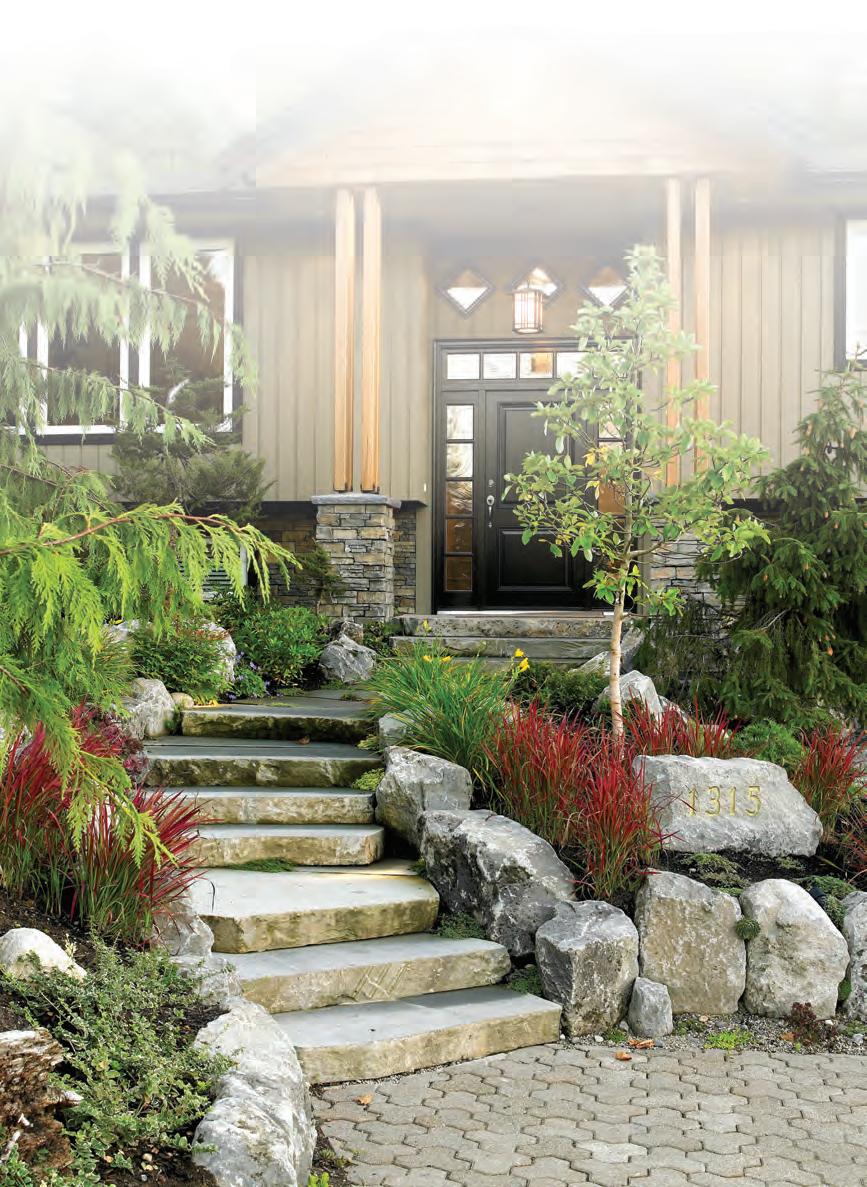
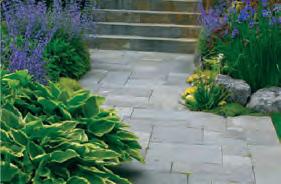



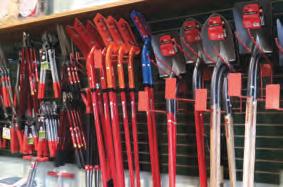

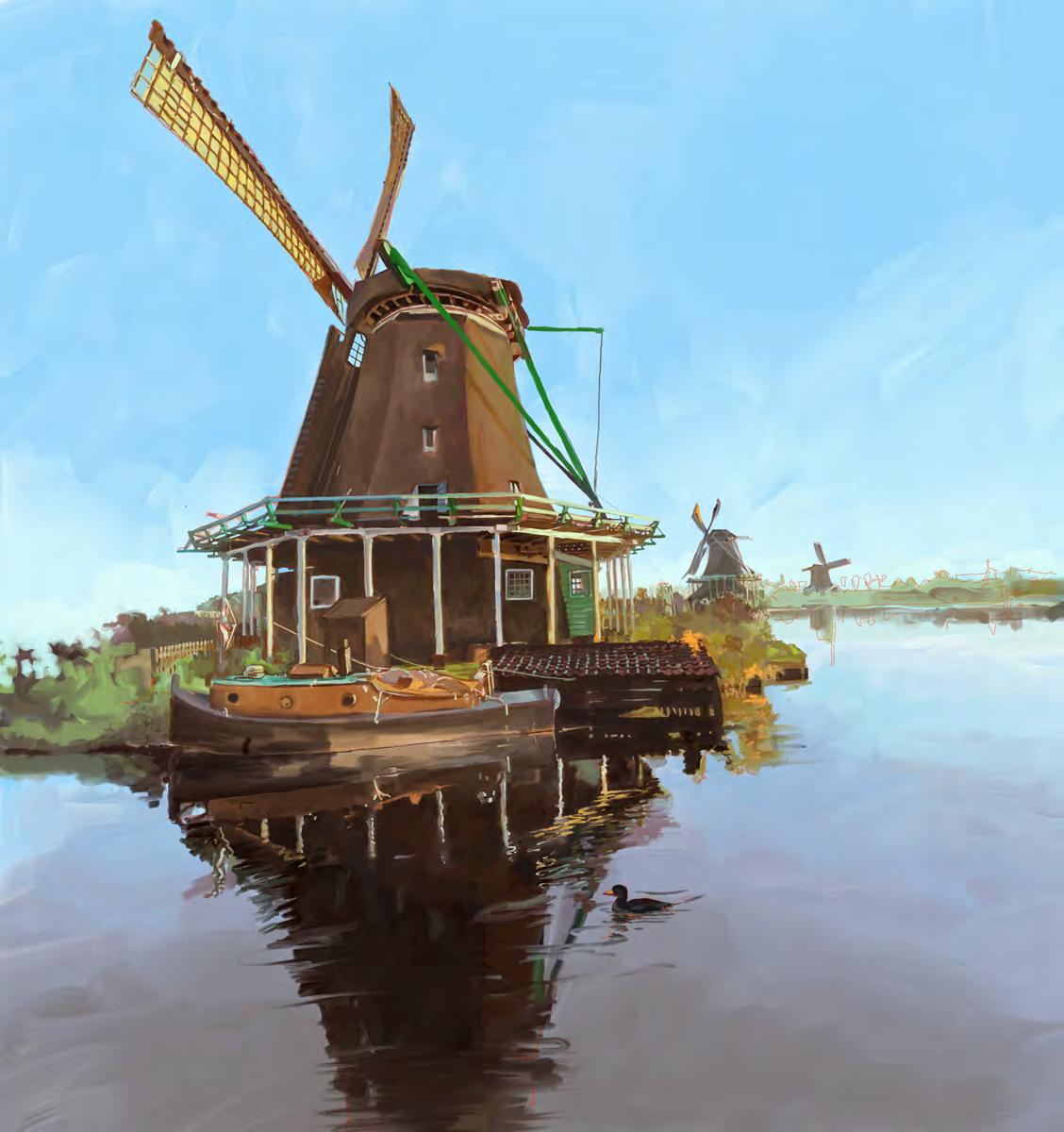
SOARING
We awoke that day with no plan, no direction.
It was November 2022, and we had travelled a painful journey to arrive at this destination. Grief, we had learned over the past 12 months, is unpredictable. It lives with you, carried inside your chest, crushing your heart. It stabs you in the dark. And the path you walk with grief hits detours and setbacks.
So, the four of us arrived at this place uncertain of how the day would unfold. Derrick—my ex-husband, the father of my adult daughters, Danica and Sierra, and Sandra’s partner for the past two decades—died on this day a year earlier, one month after a cancer diagnosis. On that morning, less than 24 hours before his 65th birthday, he took his last breath as Sandra held him and Sierra sang the lyrics from her song “Forest Floor.” It was his favourite.
Let me down easy, baby / Lay me down on the forest floor
Derrick’s and my path had parted 20 years earlier, and I was happily remarried. But we were friends, and he was the keeper of many of our memories. And so I met grief. But however sad it was for me, watching my daughters traverse this terrible new world made it doubly heartbreaking. There is no road map for grief, and at times both girls seemed lost. It struck me that making sense of death is an ironic part of life. The death of someone you love is an unendurable tragedy, yet it is something that most of us will experience. Grief is universal, but that doesn’t make it any easier to navigate.
We saw eagles everywhere after Derrick’s death. I locked eyes with one on a roadside post. Another circled above Derrick and Sandra’s lake-front home. My husband Bruce and I stepped from a forest trail onto a beach and suddenly found ourselves amid a soaring, flapping, diving aerie of eagles. Derrick always said he wanted to come back as an eagle.
And there were other birds too—the osprey that whistled through the air above us during Danica’s wedding at the lake front. And the tiny bird that alighted on a wall behind Sierra’s shoulder as she and her partner sang “Forest Floor” at an outdoor music festival in Switzerland. The bird stayed for the entire song, they were told, and seemed to be singing along.
I loved the thought of Derrick’s spirit dipping and diving, singing and catching the thermals. I envisioned him freed from the demons that sometimes ensnared him in life and filled instead with light and levity.
So, now, one year later, Sandra, Danica and I landed in Amsterdam to meet up with Sierra, who had a rare day off during a European tour. Sandra and I—our gentle camaraderie of the past two decades now a firm friendship—flew from our homes in BC; Danica came in from New York.
And we awoke that day with no plan.
The weather in Amsterdam was unusually mild, the sun a beacon of gentle warmth, cascading its light on the cyclists
and pedestrians who crisscrossed the arched bridges and narrow roadways along the edge of the canals. The chime of bike bells stirred a random rhythm amid the low hum of the city, and the cheerful reds, yellows and blues of the buildings were mirrored in the canals—the vision reminiscent of Derrick’s photography. He loved capturing reflections.
At breakfast, a vague plan emerged as we peered at a map and decided to rent bikes and cycle 14 kilometres to the neighbouring town of Zaandam. Sandra would bring a bag of Derrick’s ashes for scattering if the opportunity arose. In life, Derrick wasn’t much of a traveller, overwhelmed by anxiety around flying. But he and Sandra owned a second home in Mexico, and she and the girls spread some of his ashes there. And for the past year, Sandra had slowly released small handfuls of ash in other places she travelled, like London and Paris, but also in all corners of our island home, mostly by the water—spots that he cherished.
“Water is truth,” he used to say.
It was a glorious, glorious day as we set off on the bikes. The wind tousled our hair under our helmets, the air smelled sweet and fresh, and the sun sat on our shoulders as we flew along the bike paths. It had been years since I’d ridden a bike, and it felt like I had wings. Exhilarated, we glided and giggled. Sunshine and laughter broke out on a day we thought destined to be cloudy and sad.
In Zaandam, we discovered nearby Zaanse Schans—a collection of historic windmills and wooden houses—and we turned our bikes in that direction, whisking through backroads and pathways, and eventually arriving at a small peninsula, where three historic windmills slowly spun above us.
Leaving our bikes, we gathered below one of these windmills. It had a thick brown tower and splashes of bright green, red and white paint. Each blade flashed yellow as it turned and caught the sun. A matching brown, green and white wooden boat sat directly beneath it, and the entire visage was reflected in the water between the windmill and the small strip of sand, where we stood at the water’s edge. A picture-perfect reflection.
Sandra brought out Derrick’s ashes and we dipped our fingers into the bag, collecting the ash which fluttered up as we released it, before settling on the glassy water. The sun, just starting to set, cast beams of light that wrapped us in a golden hug.
As we stood in silent reverie, a pair of ducks swam towards us, and we took note because the male was unusual in its all-black colouring. It broke away from the other bird and paddled in close. And we had to smile because black was, of course, Derrick’s trademark colour. He rarely wore anything else. Then the black duck turned, caught up with his mate and they swam away to join a distant flock.
In that moment we found peace with our grief; we understood it was possible to live and even be happy alongside heartbreak. And so we soared.
If you have a story to share, and the ability to write about it, please send Narrative section submissions to susan.lundy@blvdmag.ca.
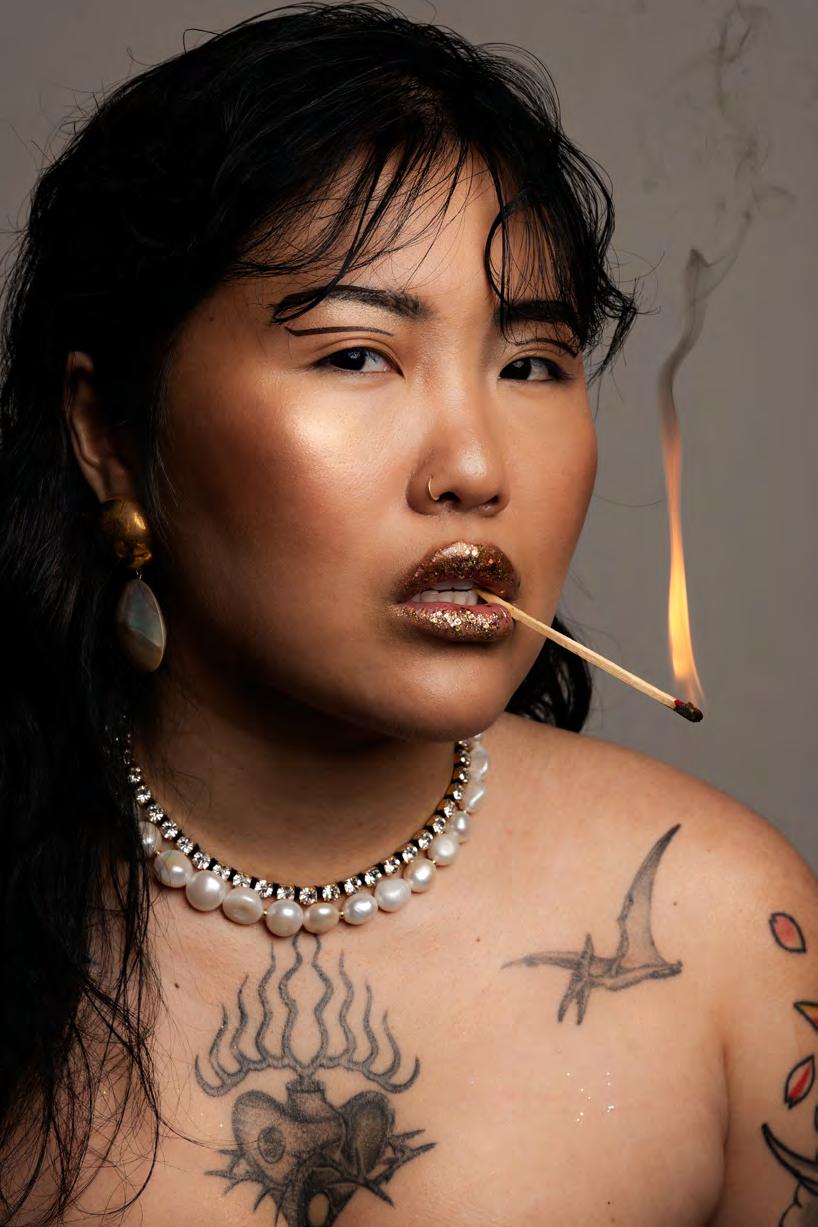
Honour yourself. Accept who you are. Prioritize your own needs and well-being. Treat yourself with kindness and forgive yourself as necessary. These are the cornerstones of selflove, which is at the core of self-care, the theme that weaves through this edition of Boulevard
Self-love is also the spark for the concept behind the fashion story in this issue of Boulevard Here, makeup is used in joyful, whimsical self-expression—applied purely for one’s own delight—and our models present as stridently unapologetic of who they are.
Makeup artist Jen Clark adds, “This was an opportunity for playful makeup application, using the face as a playground for expression. I was going for unexpected rather than perfection.”
In times past, self-love may have expressed itself in consumerism and the collection of material things. However, in this era, with its focus on wellness and self-care, self-love is the seed from which everything else grows. This is a time to focus on inner work, to build self-compassion and bloom as the most glorious version of yourself.
PHOTO BY LIA CROWE

